Allison Collection Photos
March, 1942
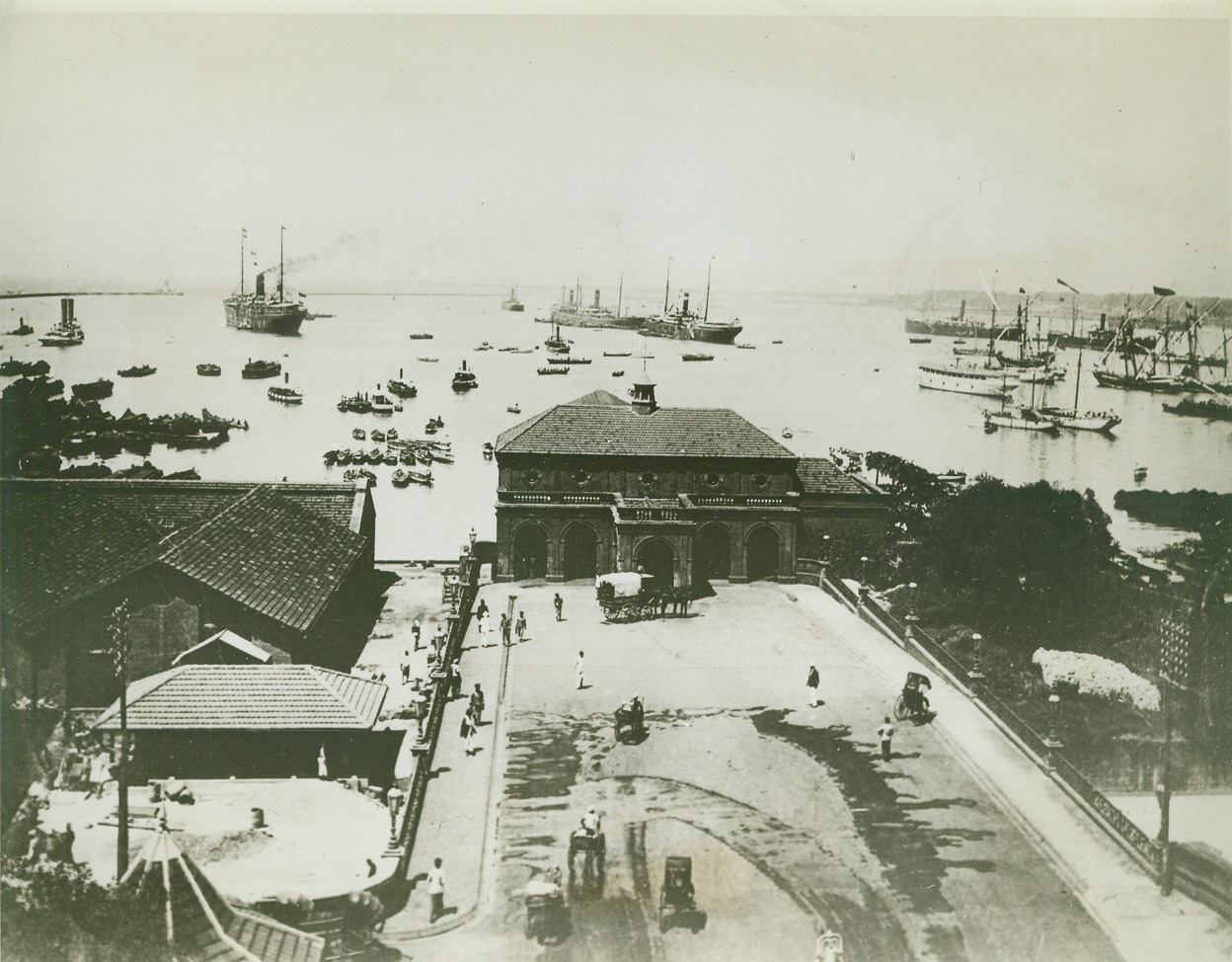
CEYLON CALLED KEY TO INDIA AND ALLIED LIFELINES, 3/11/1942. The Island of Ceylon, only 18 miles from southern India, with its strategic Naval Base at Trincomalee commanding the sea routes to India, to Russia, and to the jumping off place in the new lifeline to China from Calcutta, must be held at all costs as the key to vital supply lines to and from the Near and Far East and as a possible starting point for a United Nations counter-offensive, says Professor William A. Beer of Boston University, onetime Trade Commissioner from Ceylon to U.S., who spent 16 years on the Island. “If the Japanese should gain control of Ceylon,” he continued, “the industries of India would be immobilized because of lack of transport, it would be difficult to use her available manpower in any offensive back over the routes that Japan already has traveled, and finally, Russia and China, would be effectively isolated from Allied Aid” Here are some scenes on the important island. Scene at Colombo, the capital and main seaport on the S.W. coast (pop. 284,000). Credit: ACME;
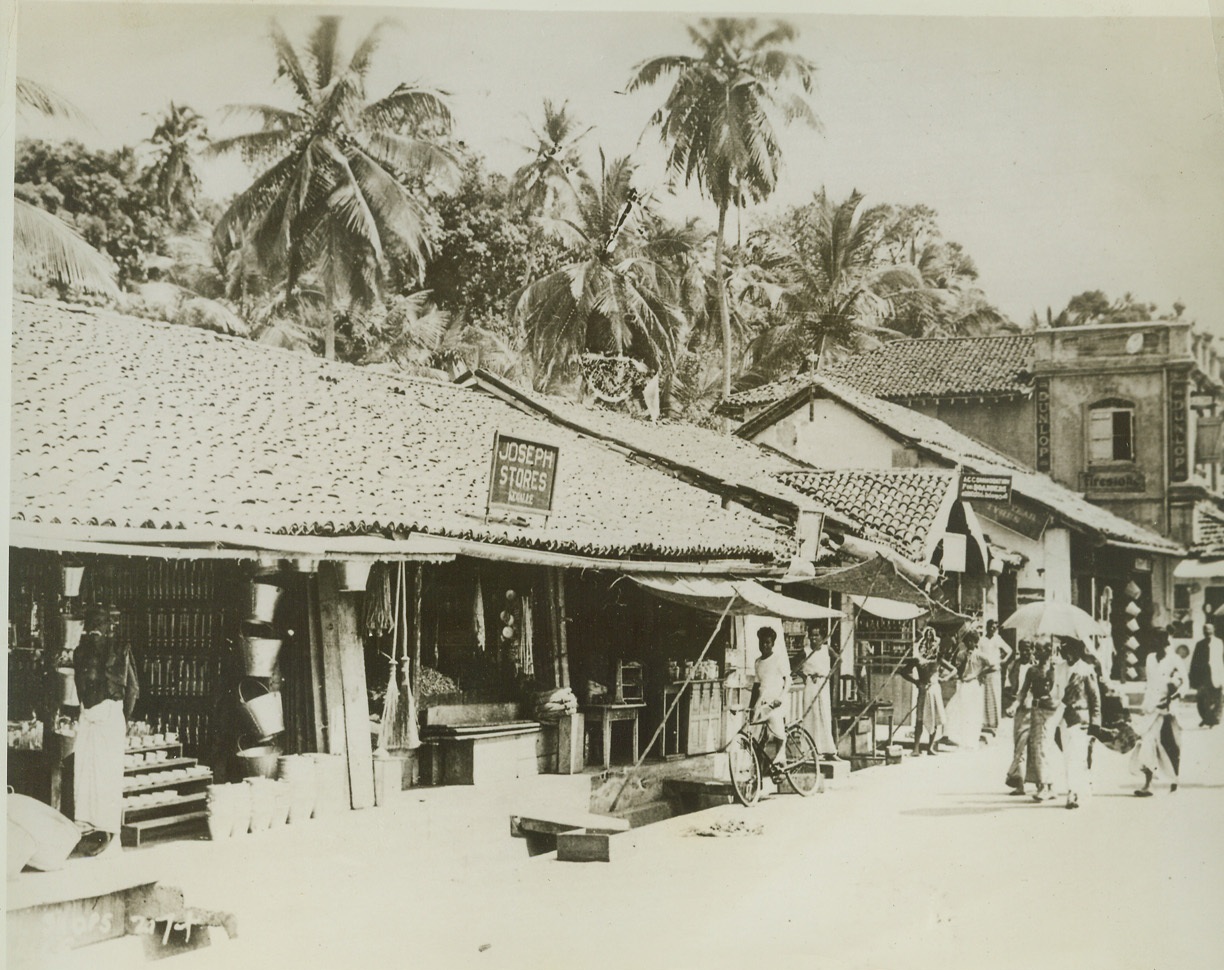
CEYLON KEY TO INDIA AND ALLIED LIFELINES, 3/11/1942. The island of Ceylon, only 18 miles from Southern India, with its strategic Naval Base at Trincomalee commanding the sea routes to India, to Russia, and to the jumping off place in the new lifeline to China from Calcutta, must be held at all costs as the key to vital supply lines to and from the Near and Far East and as a possible starting point for a United Nations counter-offensive, says Professor William A. Beer of Boston University, onetime Trade Commissioner from Ceylon to U.S., who spent 16 years on the island. “If the Japanese should gain control of Ceylon,” he continued, “the industries of India would be immobilized because of lack of transport, it would be increasingly difficult to use her available manpower in any offensive back over the routes that Japan already traveled, and finally, Russia and China would be effectively isolated from Allied Aid. Here are some scenes on the important island. Credit: ACME;
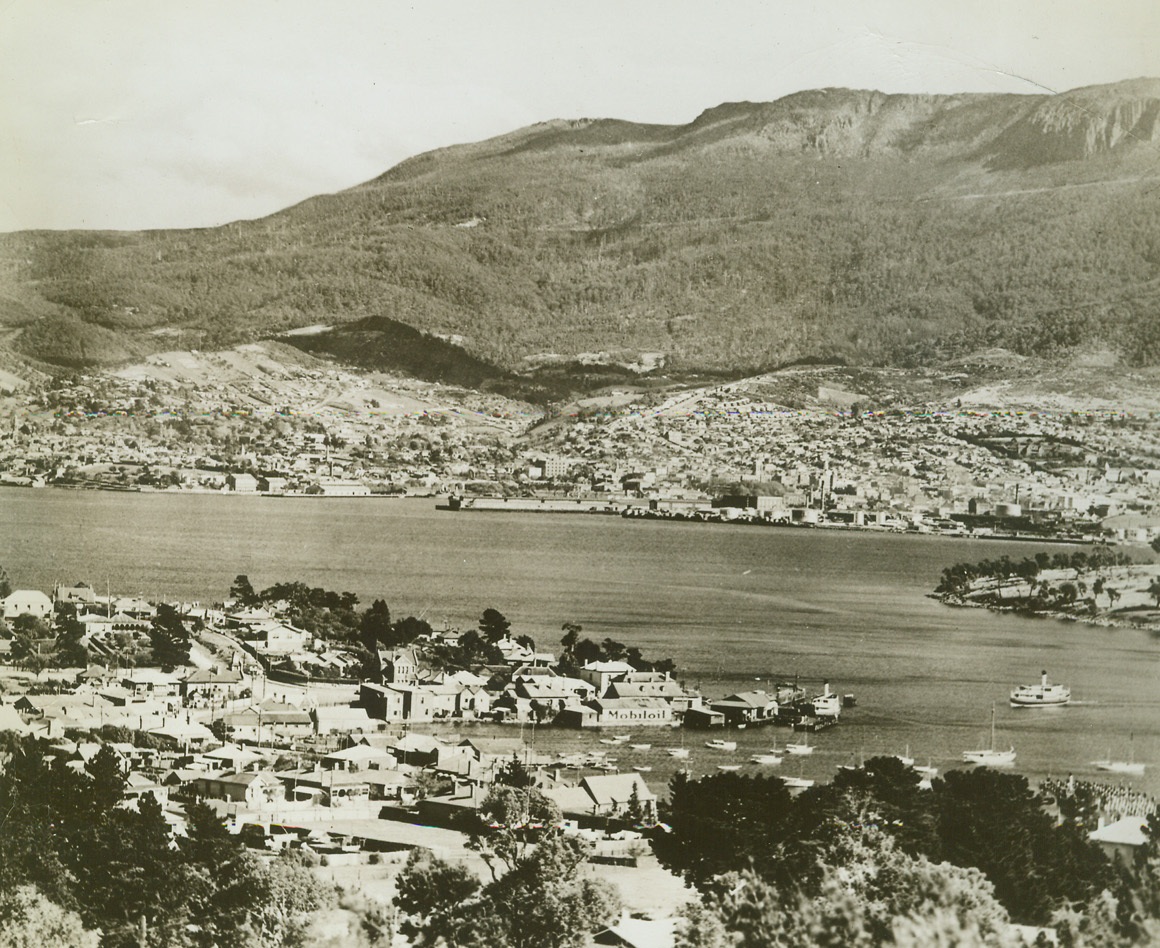
Tasmanian Capital, 3/14/1942. The island of Tasmania, which lies off the Southeast coast of the Australian mainland, is another possible invasion point in the Jap surge through the Southern Pacific. Here is a view of Hobart, Tasmania’s capital. Mt. Wellington dominates the Harbor. Hobart is the Southernmost of the Australian capitals.Credit Line (ACME);
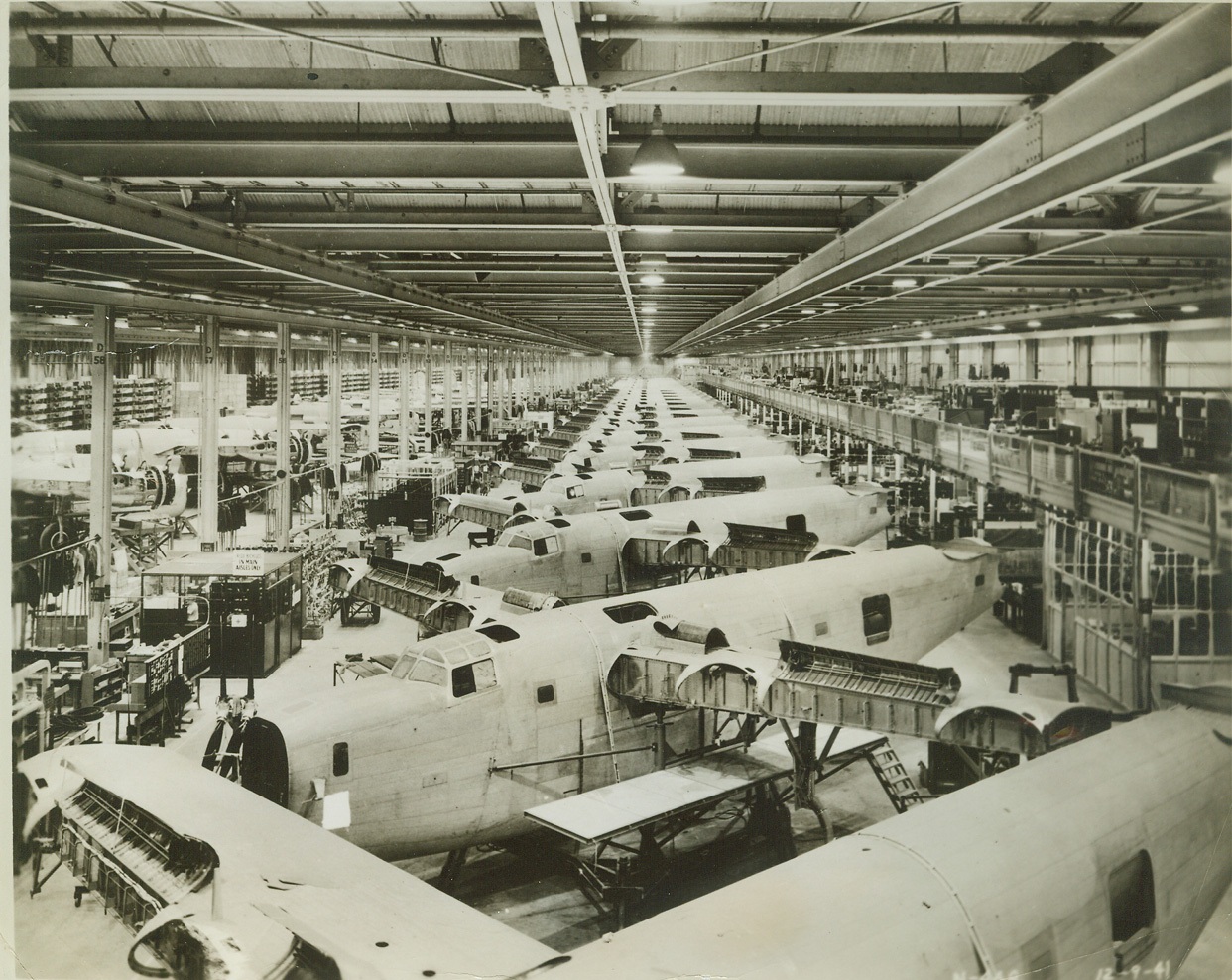
Giant Bombers in Assembly-Line Production, 3/15/1942. SAN DIEGO, CALIF. -- Giant four-motored bombers on a moving assembly line are the Consolidated Aircraft Corporation's answer to the wartime demand for "more planes faster." Almost as far as the eye can reach the line moves along until fully completed planes roll off ready to do battle. Credit: (ACME);
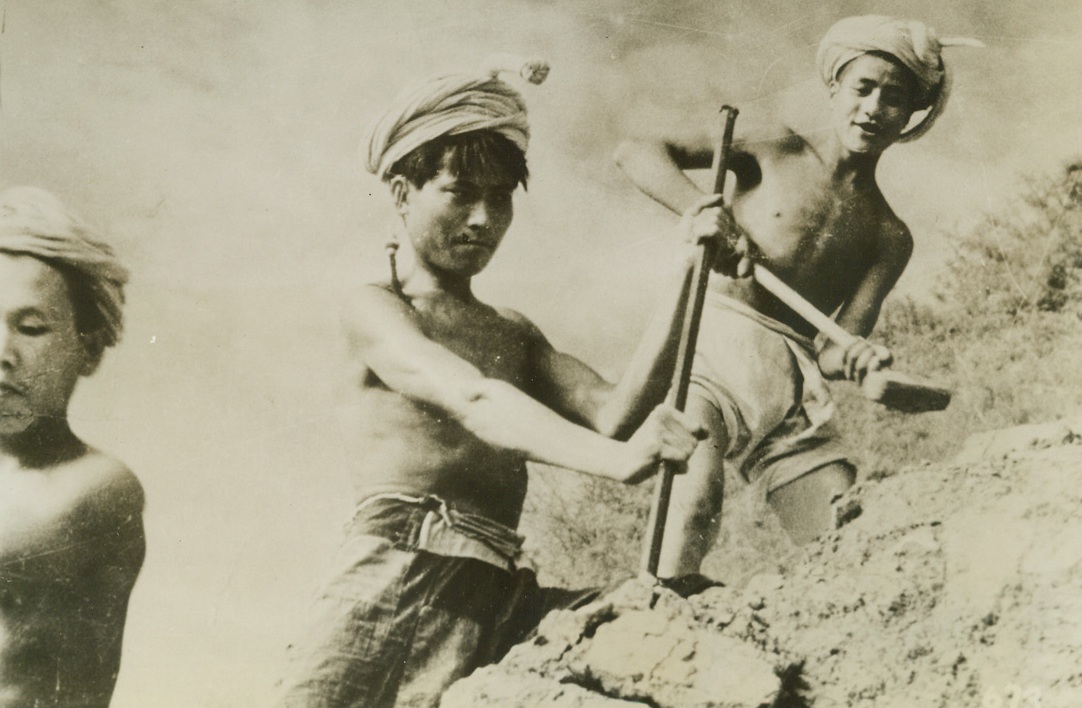
HARD GOING THROUGH THE HIMALAYAS!, 3/16/1942. CHINA—Chinese roadbuilders encounter solid granite as they rush to cut a vital highway from China through the Himalayas into India. Seven thousand workmen have already lost their lives, falling to death over the precipices or dying from exposure and illness. The new road will replace the now useless Burma Road. Photo is believed to be one of the first actual scenes of roadbuilders on the new road. Credit: Acme;
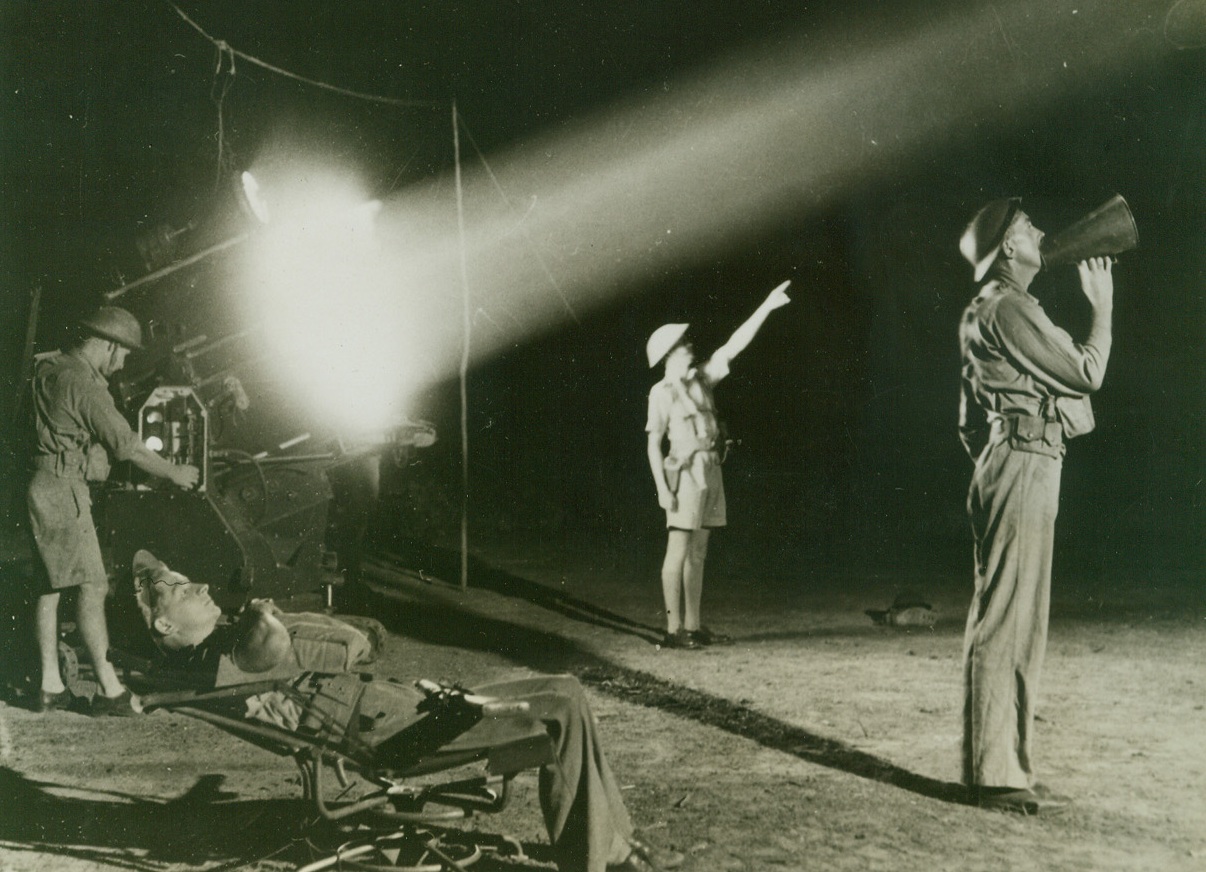
DARWIN GIRDS FOR ITS DEFENSE, 3/16/1942. DARWIN, AUSTRALIA—With the threat of Japanese invasion ever nearer, Darwin, leading city and military bastion in northern Australia, is feverishly equipping strong anti-aircraft defenses as well as protection against seaborne landings. Photo shows an anti-aircraft searchlight unit during its all-night vigil against Nipponese planes. Already Darwin has been bombed and machined on three occasions. Credit: Acme;
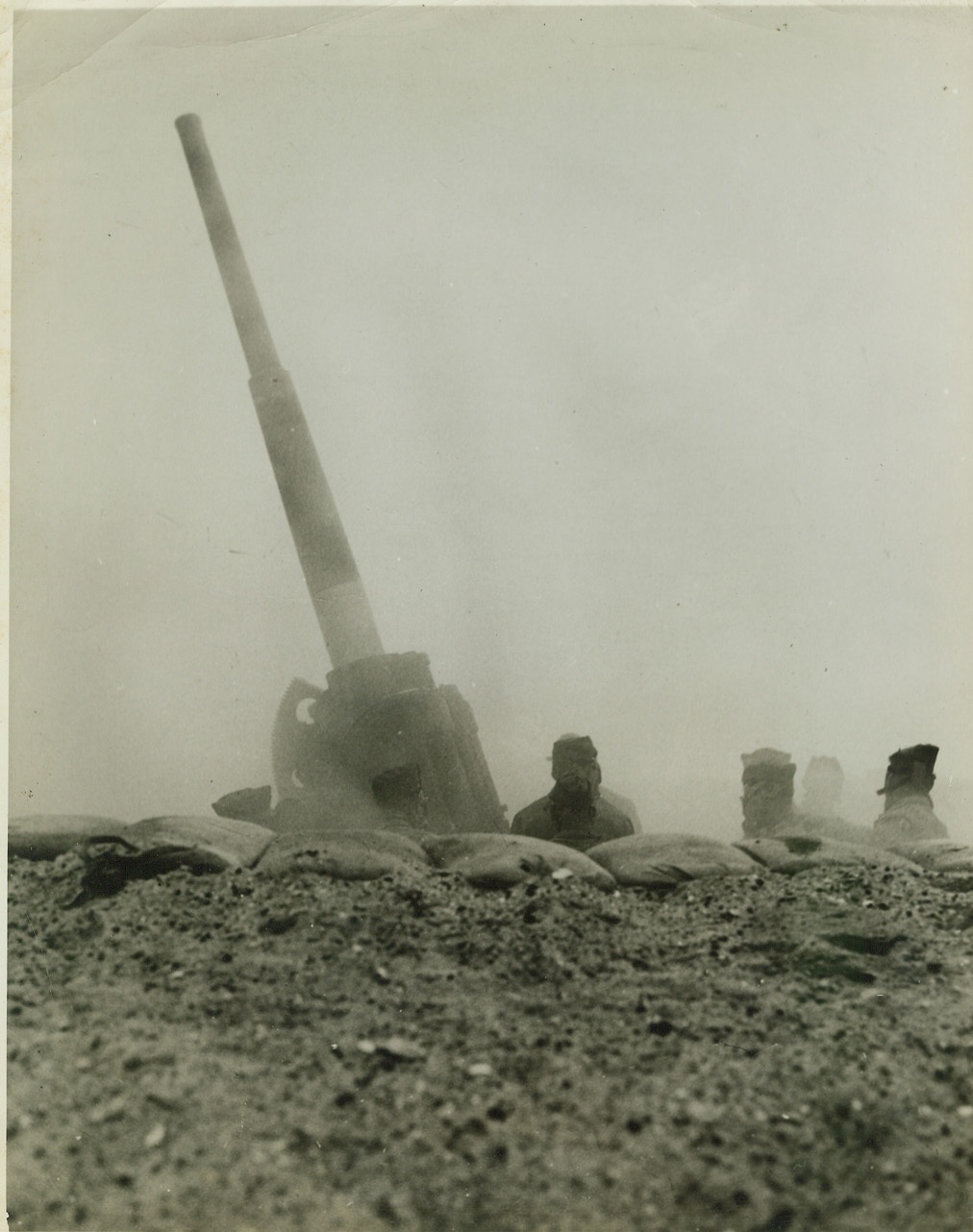
GAS ATTACK (MOCK) HITS FORT MONROE, 3/18/1942. FORT MONROE, VA. - Smoke and gas cloud the crew and emplacement of an anti-aircraft gun at Fort Monroe, during a recent simulated attack by gas-carrying planes. Note soldiers wearing masks. This was the largest actual gas demonstration to have been carried out, thus far, on the Atlantic Coast. Credit: OWI Radiophoto from ACME;
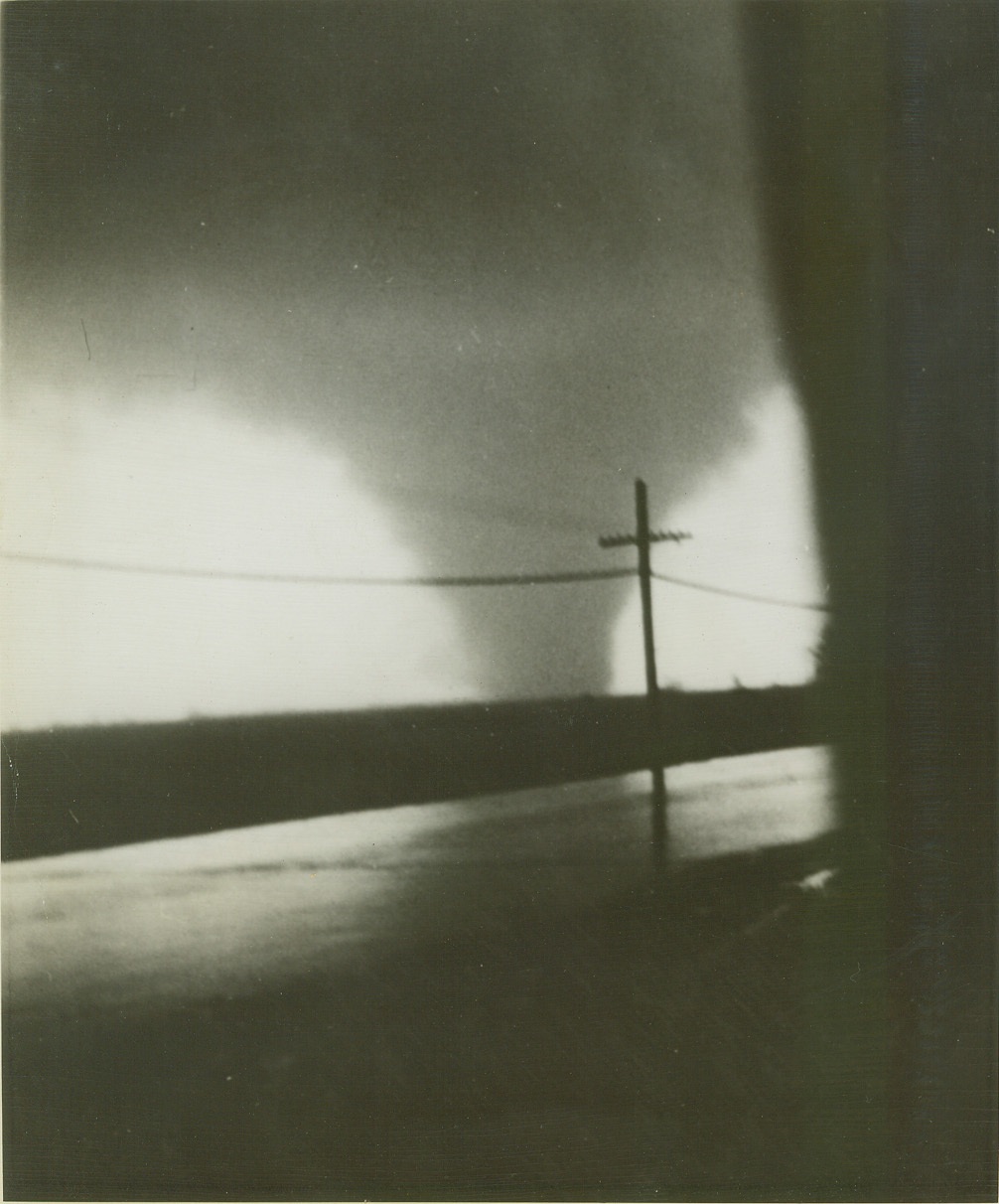
FUNNEL OF DEATH, 3/19/1942. DANVILLE, ILL. – A. J. Weber of Collinsville, Ill., shot this photo of a twister as it approached Illinois Highway No. 1 North of Danville, Ill., on its sweep across several counties, leaving death and destruction in its wake. It was one of the tornadoes that struck the Midwest from Illinois to Mississippi March 16, killing over 150 persons, injuring nearly 1,000. Credit: ACME photo;
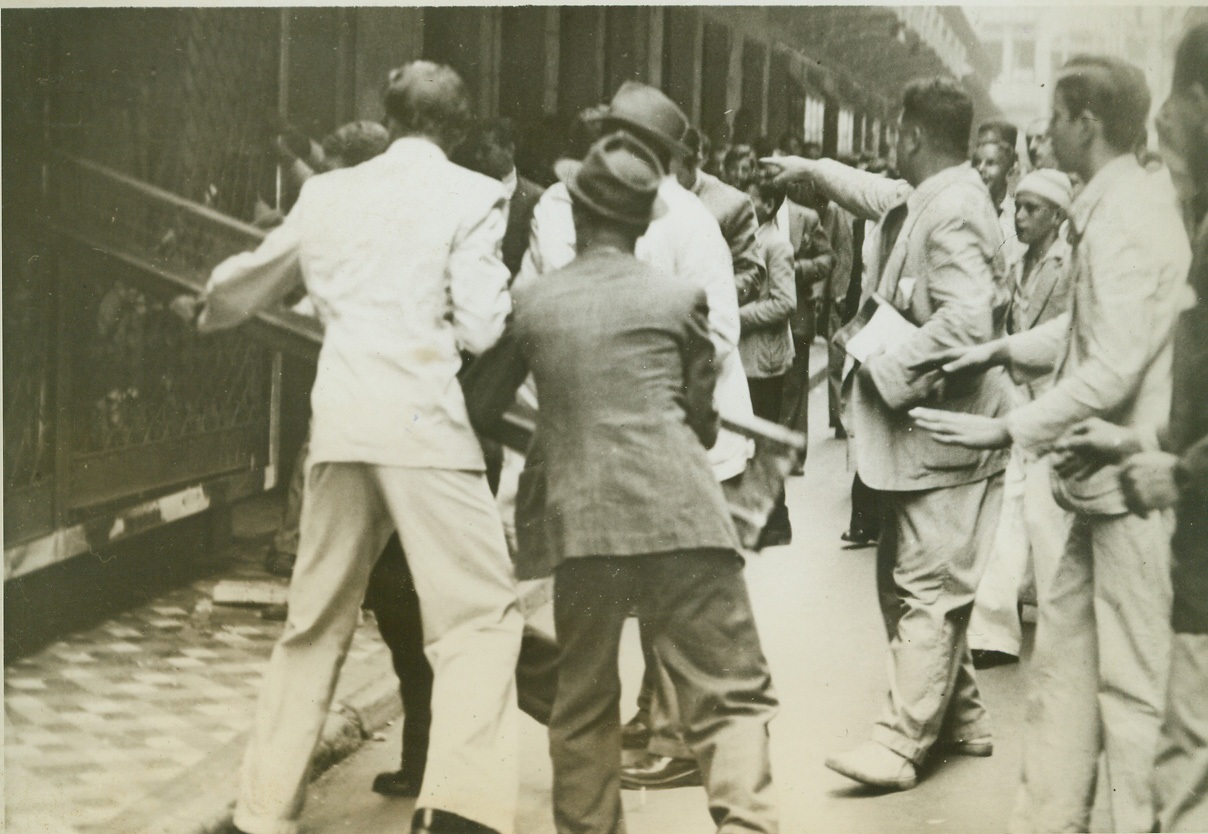
AXIS STORES SMASHED BY RIO DEMONSTRATORS, 3/19/1942. RIO DE JANEIRO – The “Cariocans,” as super-patriots in Rio de Janeiro call themselves, strongly resented the sinking of Brazilian ships by Axis warcraft, and so they took the law into their own hands, March 12, and smashed German stores and other Axis establishments. Here, a crowd of the demonstrators is shown as it smashed windows in the Case Alema, a German department store. Credit: ACME;
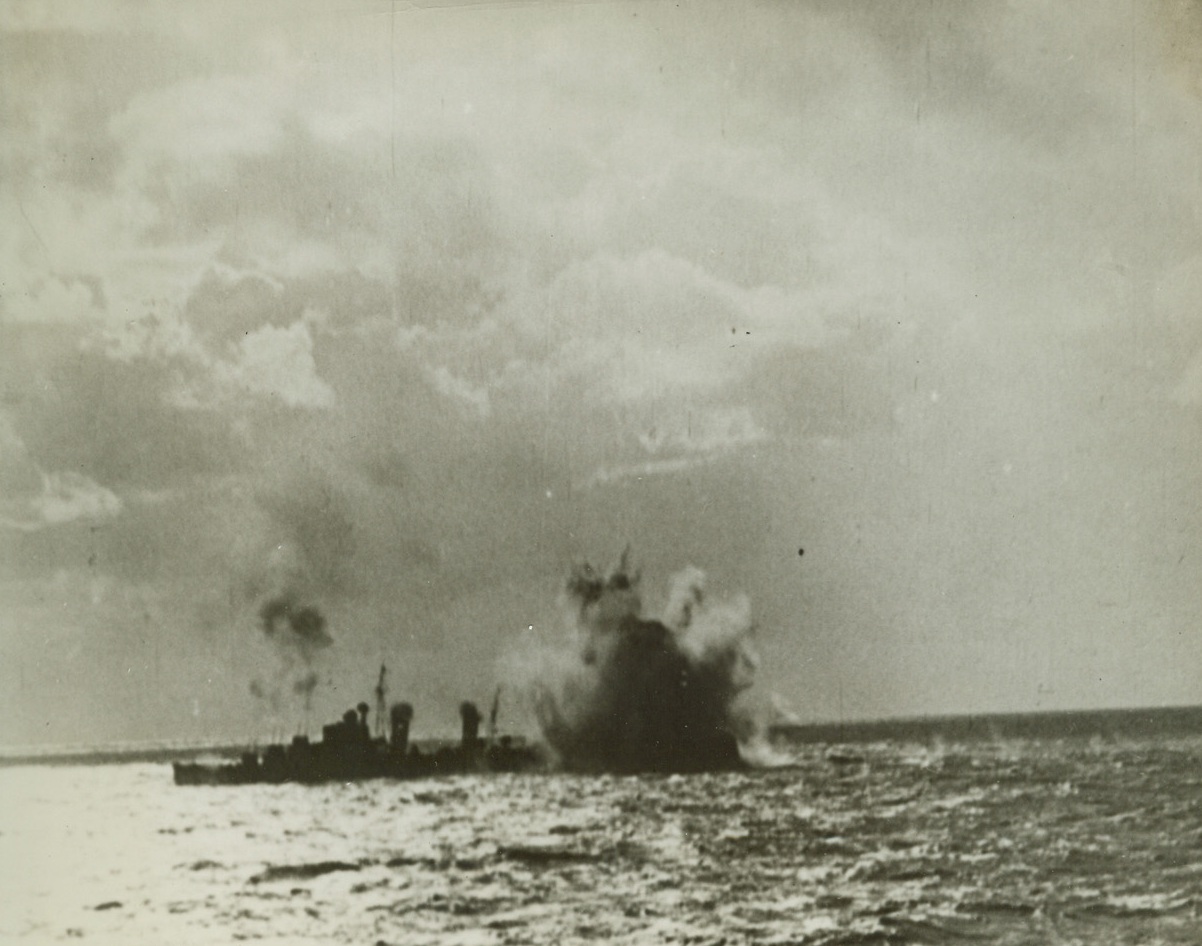
A MISS IS AS GOOD AS A MILE!, 3/19/1942. SOMEWHERE IN THE MEDITERRANEAN—An aerial bomb as it exploded just short of the stern of a British destroyer, protecting a convoy bound for Malta. But—“a miss is as good as a mile,” and the craft’s anti-aircraft guns can be seen firing at the raiding planes from the forward part of the destroyer. Credit: Movietone News photo from Acme;
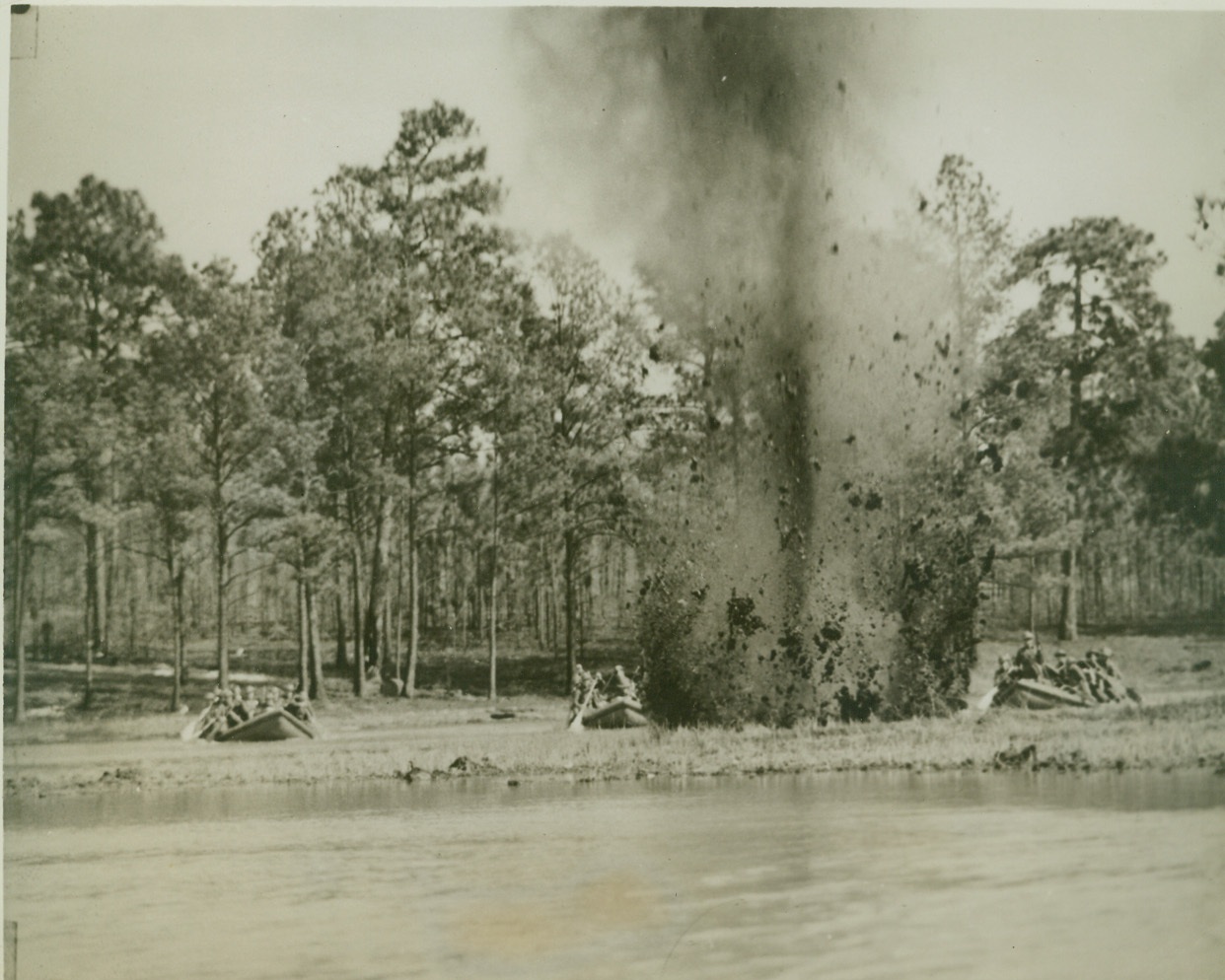
Uncle Sam’s ‘Invasion’ Troops in Training, 3/22/1942. Ft. Bragg, N.C.—Blast from charge of explosives set off in the water sends mud flying as troops of the 9th Infantry Division approach shore. These soldiers are being especially schooled in amphibious training with the use of rubber boats. Credit: ACME.;
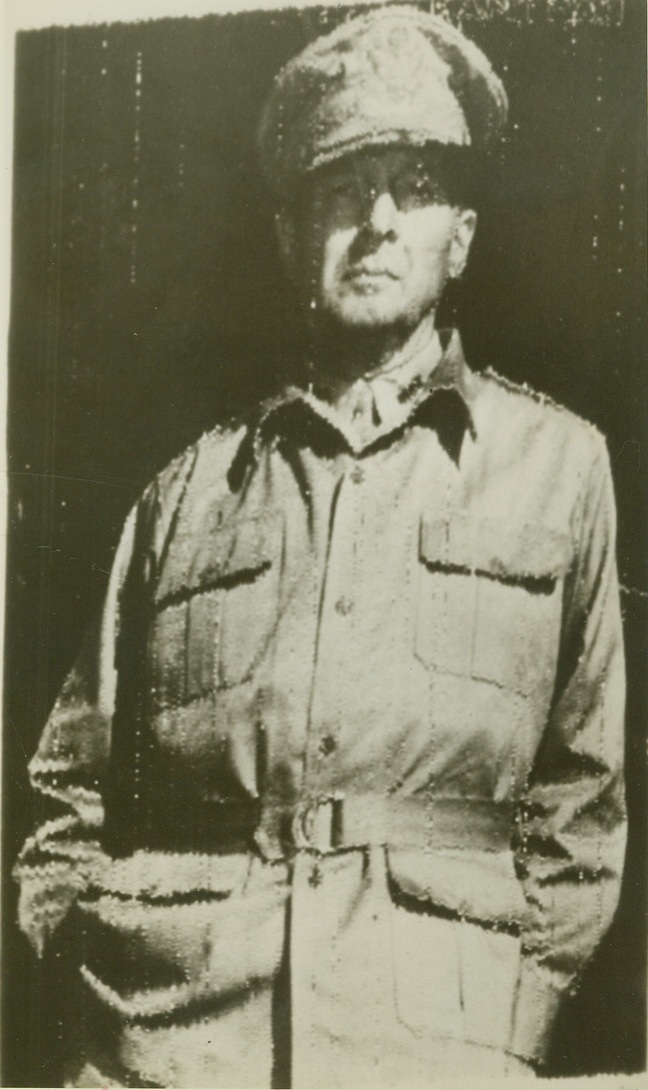
Macarthur Takes Over in Australia, 3/23/1942. Australia—Gen. Douglas Macarthur shown as he arrived in Australia after a daring flight from beleagured Rataan peninsula to take command of the United Nations forces in the Southwest Pacific, one of the first radiophotos to come direct from Australia to the United States. Credit: ACME radiophoto;
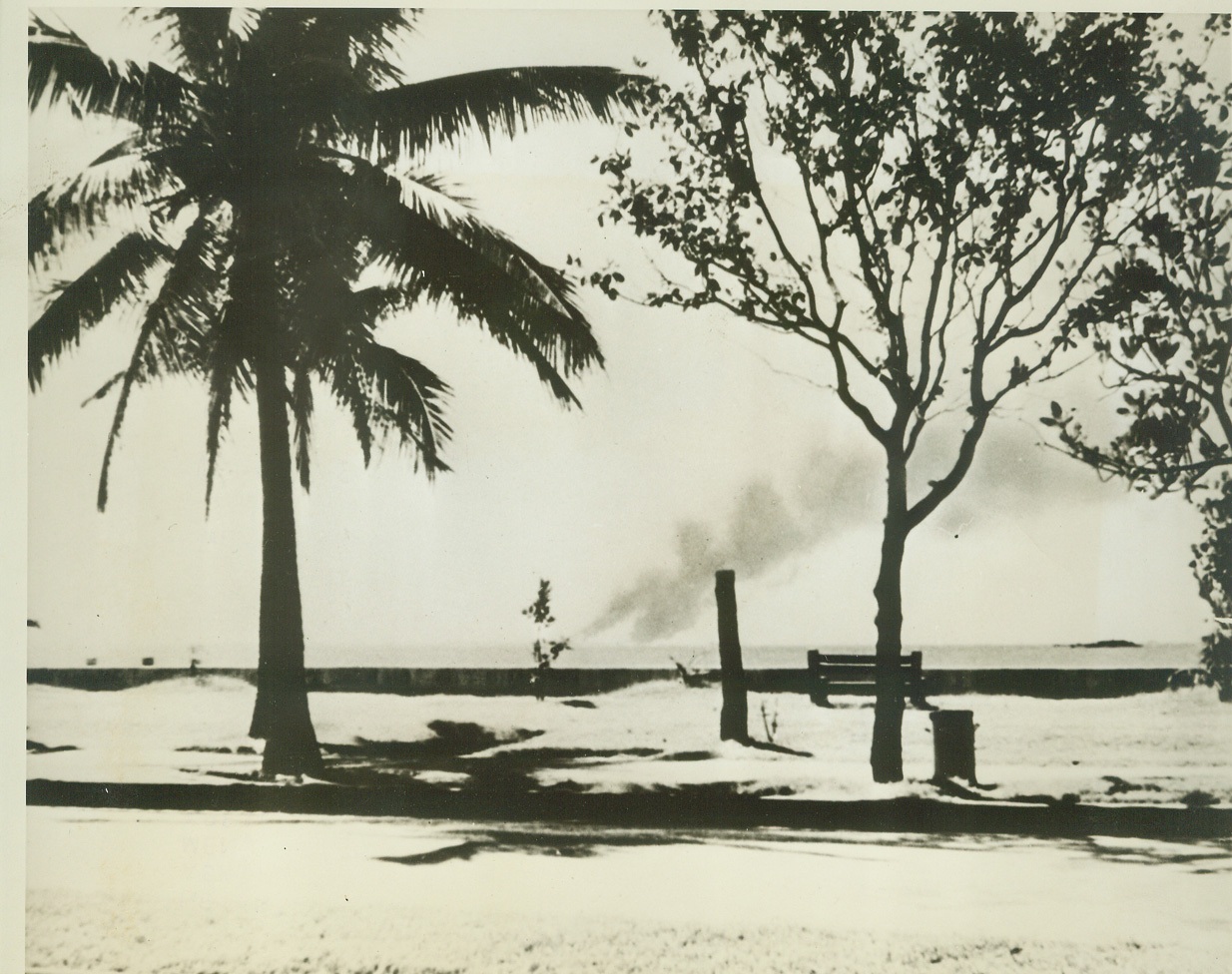
RED CROSS MERCY VOYAGE IN PICTURES, 3/26/1942. On the eve of the fall of Manila, General MacArthur cabled the American Red Cross asking for a ship to evacuate about 200 of his men, who were wounded. On Dec. 31, the small freighter Mactan was chartered by the Red Cross, and marked with Red Cross flags. It was loaded with the wounded, manned by doctors and nurses from the Philippine Red Cross chapter, and sailed early Jan. 1st, after permission had been received from the Japanese Government to pass through the war zone. This photo, and others in this set, were taken by Irving Williams, of Patchogue, Long Island, and released through the Red Cross. The wounded were taken off at Sydney, Australia. In this photo, made from Dewey Boulevard, in Manila, smoke pillars, (in background), are shown rising from the burning Naval Base at Cavite, as the Japs approached Manila. It was when it became apparent that Manila was to fall, that Gen. MacArthur asked for the “Mactan”. Credit: ACME;
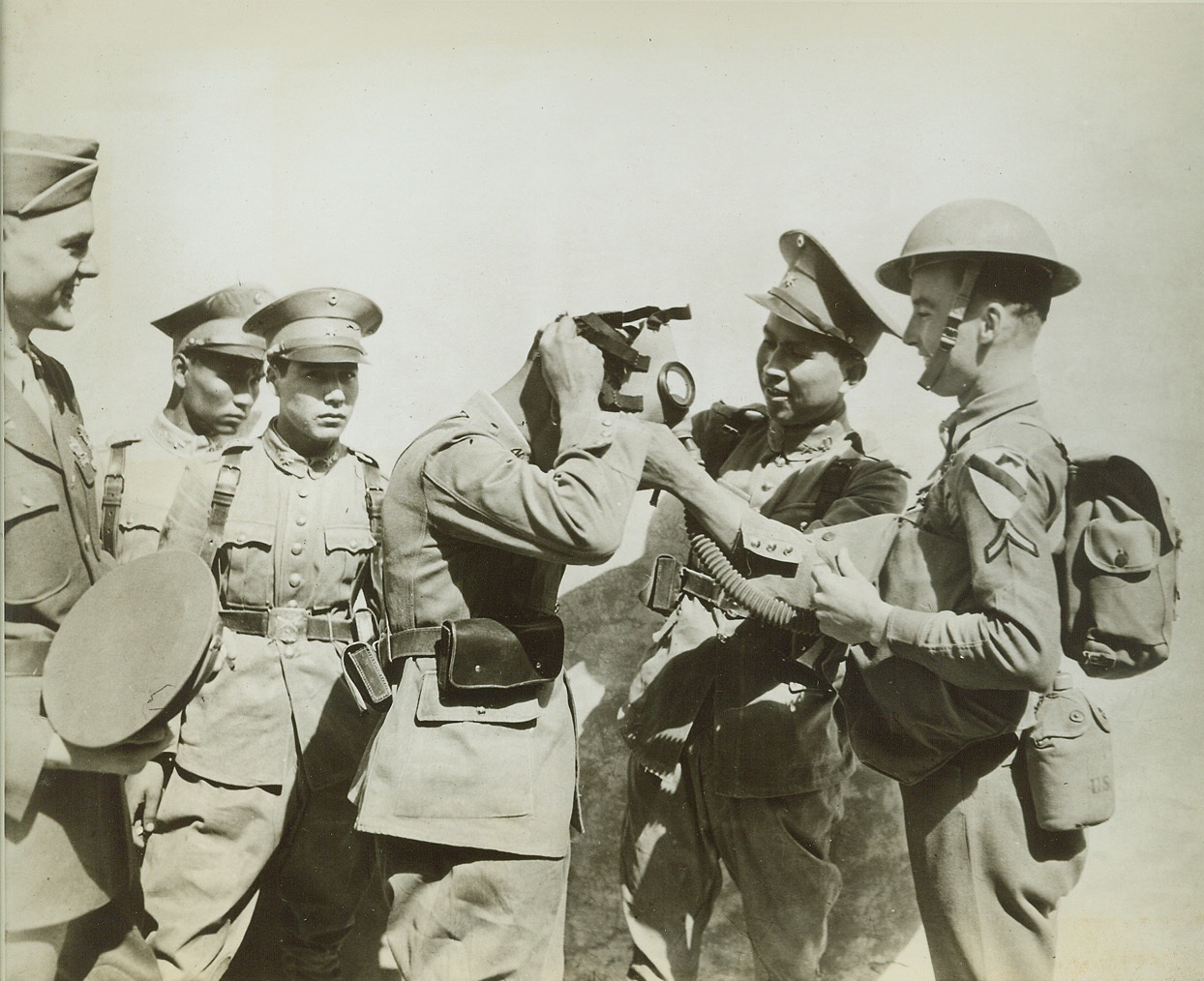
The Army’s Good Neighbor Policy, 3/26/1942. It probably wouldn’t work if they were soldiers of Axis countries…they don’t have that knack for getting along with others. But our soldiers stationed along the border believe in the good neighbor policy – it just comes natural. In El Paso, Texas, for instance, American doughboys fraternize with Mexican soldiers to the fullest and both countries permit their men to cross the borders when in uniform. New York Bureau Private First Class Fred Dean, of Abilene, Texas, explains how his American gas mask works to the Mexican soldiers visiting in El Paso. Credit: (ACME);
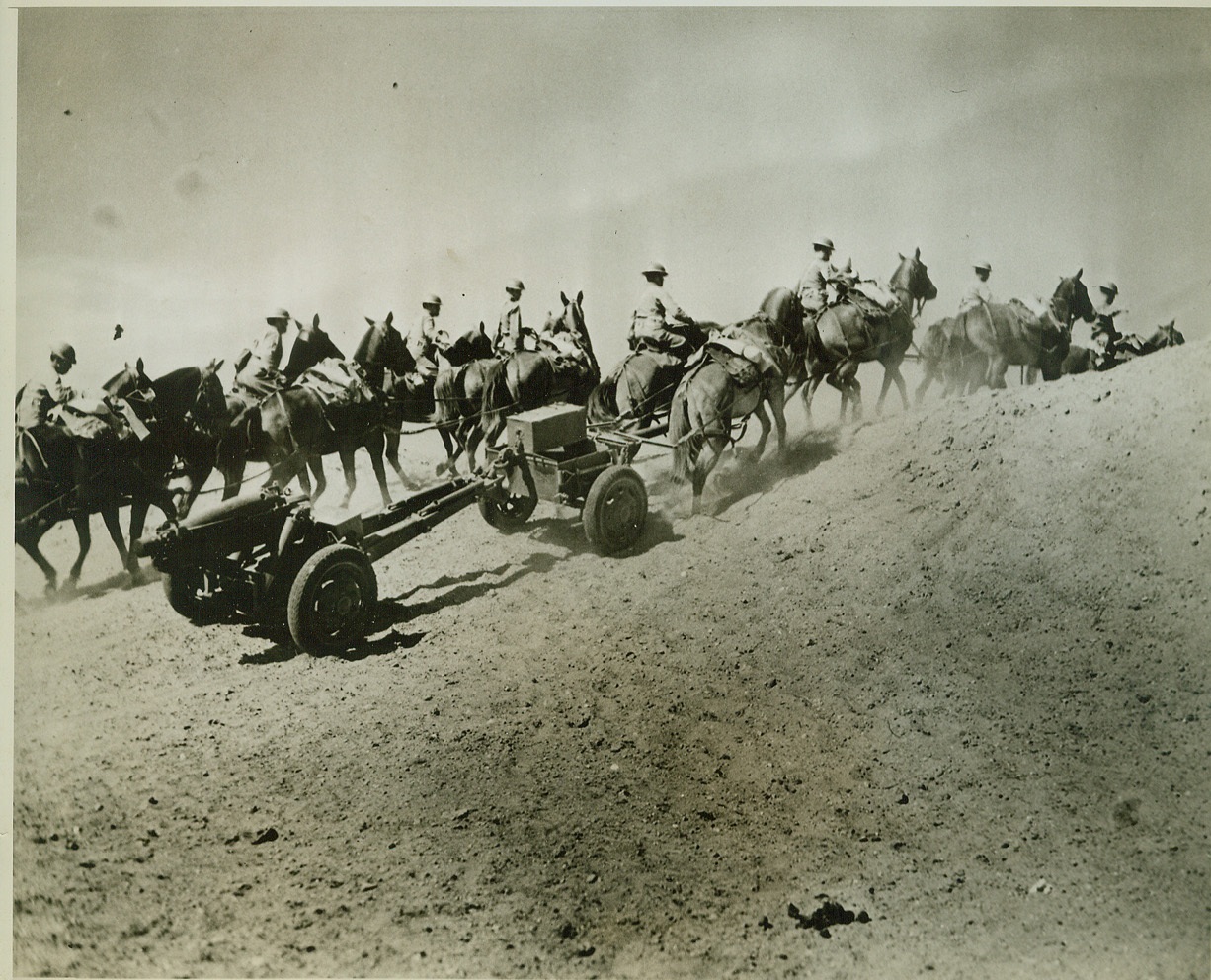
Training Our Cavalry, 3/27/1942. FT. BLISS, TEXAS – U.S. Cavalrymen participate in maneuvers over rough terrain near their reservation. Despite mechanization, horses still are of value to the Army. Note that the caisson and the howitzer (75mm. field) that it pulls are equipped with modern pneumatic tired instead of the old-fashioned iron-rimmed wooden wheels long outmoded. Credit (U.S. Army Signal Corps Photo from ACME);
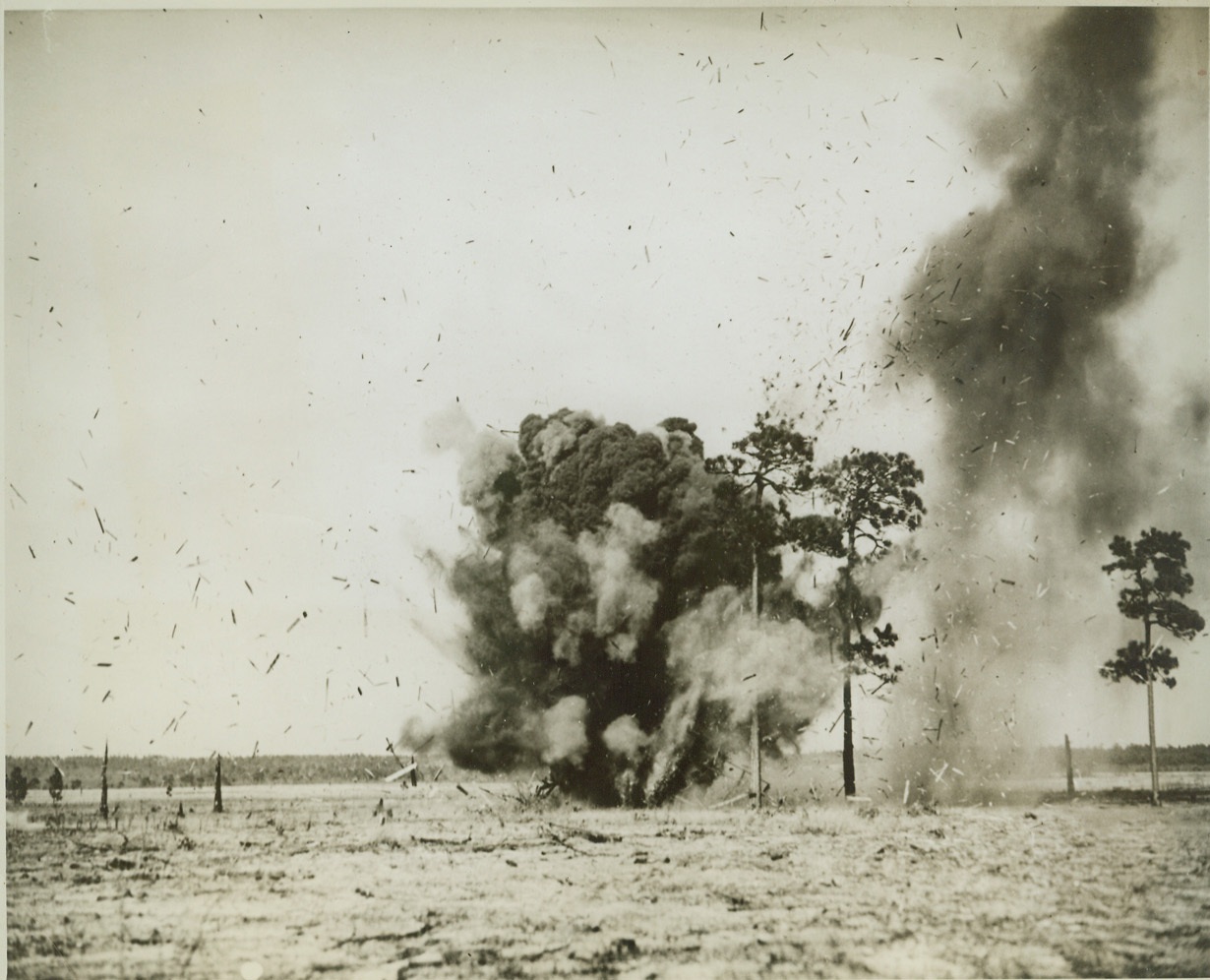
DIRECT HIT BY LONG-RANGE RIFLE, 3/29/1942. FORT BRAGG, N.C. – Debris flies in all directions as a shell from a 155mm Field Rifle scores a direct hit on a wooden shack during target practice by the 36th Field Artillery. The 155mm Rifle is the longest range – about 17 miles- field piece used by the U.S. Army Credit: OWI Radiophoto from ACME;
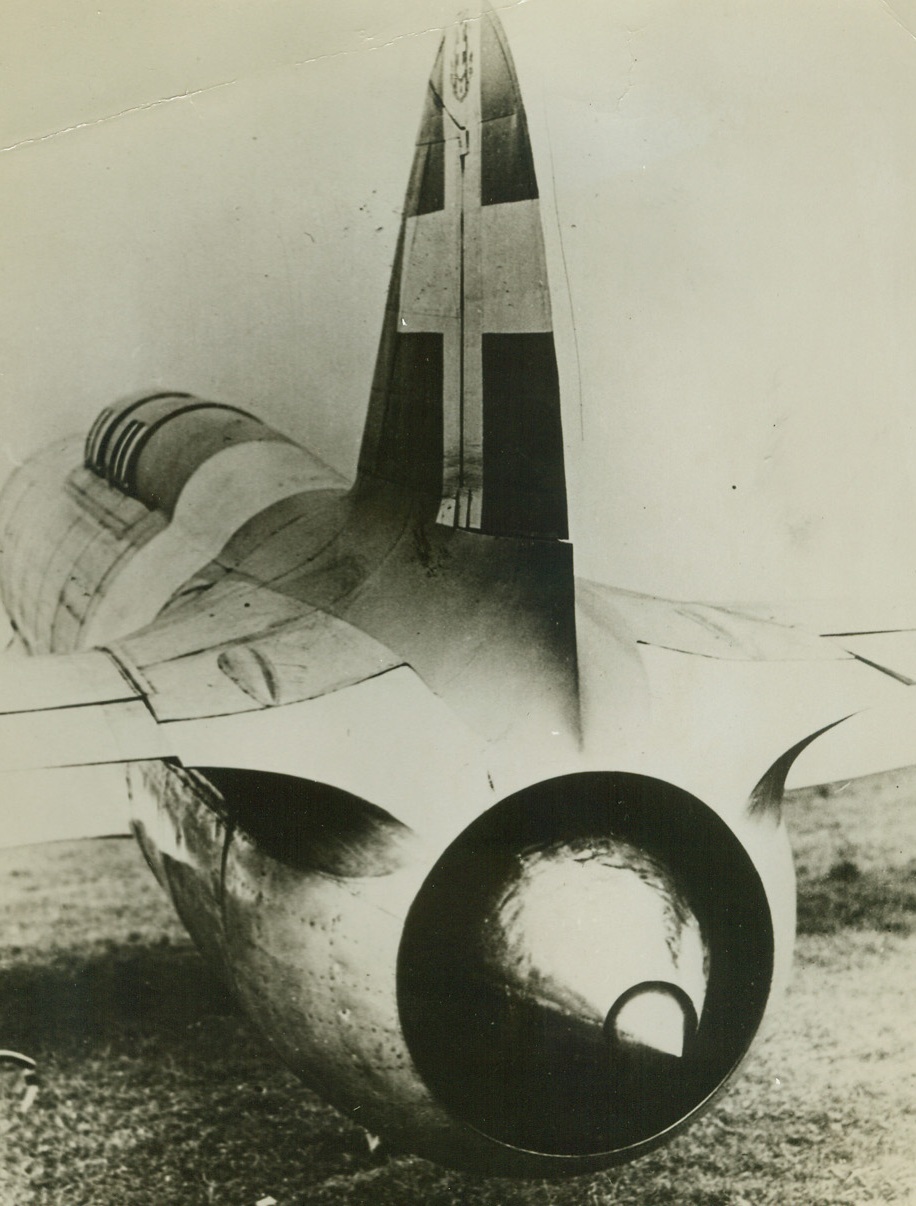
ITALIANS TEST JET-PROPELLED PLANE, 3/29/1942. The photo shows a rear view of a jet-propelled plane being tested by Italian aviation engineers. It is a two-seated, enclosed cockpit, low-wing monoplane with a large single fin and rudder and retractable undercarriage. Weighing about 11,000 lbs., its principle of operation is simple. Air enters a circular duct in the nose is expanded and passed into a compressor, which may be a normal aero-motor or an internal combustion turbine. The air is then ejected through a smaller duct with a controlled outlet behind the plane’s tail. The hot exhaust gases of the motor which drive the compressor are ejected in the same duct. The propulsive force is in the kinetic energy in the jet of air. In tests, the plane has flown comparatively slowly, about 130 M.P.H. However, no effort has been made to reach a high speed. Known as the Carroni-Campini, the plane was first tested in August of 1940. The model shown here is a later one, and improved. Credit Line (ACME);
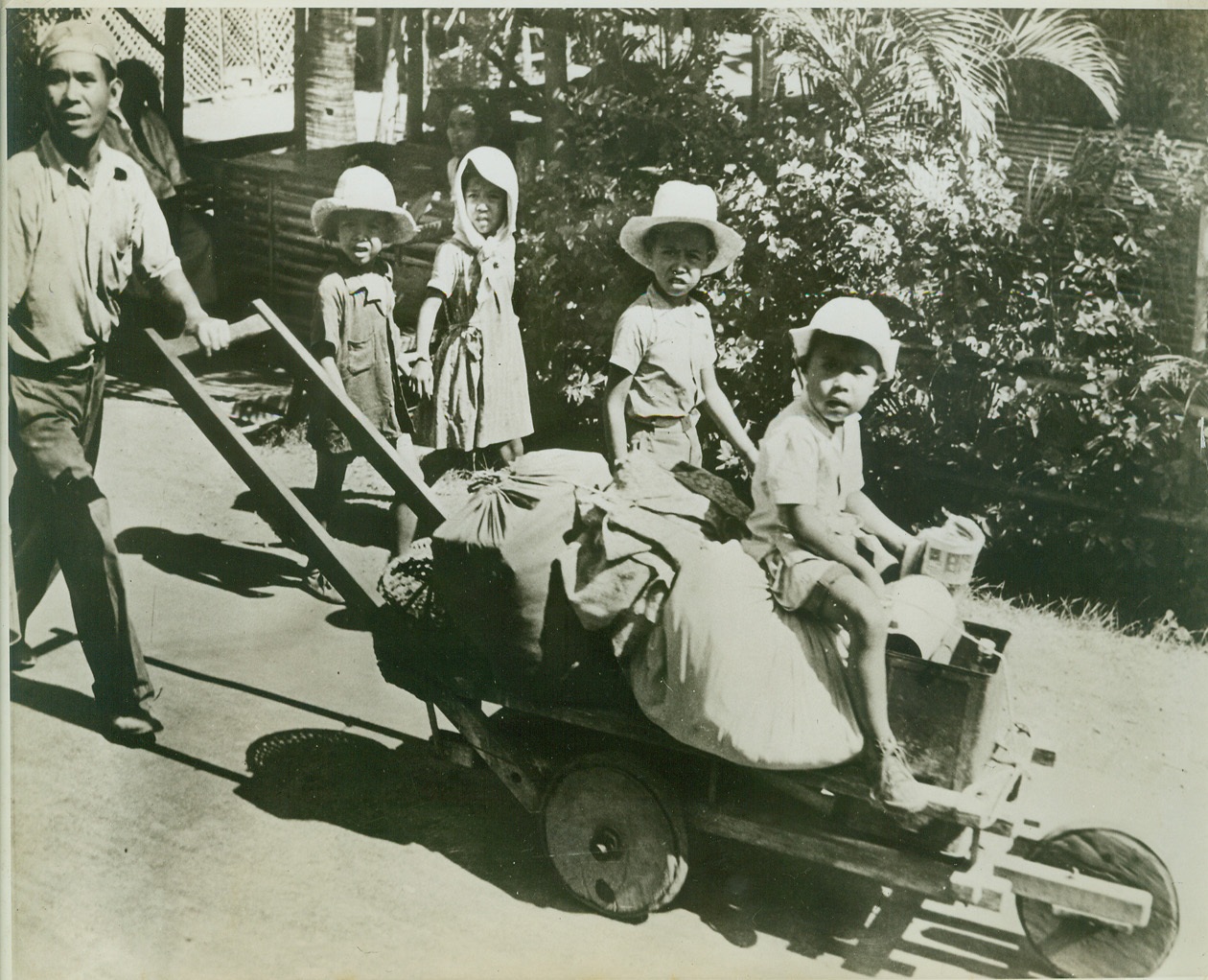
FIRST PHOTOS OF JAP ATTACK ON PHILIPPINES, 3/30/1942. This picture released on March 30th is one of the first brought out of the Philippines since the start of hostilities. It was rushed from Australia to the Capital for release by the Pictorial Branch of the War Department, Bureau of Public Relations. Photo shows residents of Cavite evacuating after the Jap bomb raid of December 10th, 1941. Credit: U.S. Army photo from Acme.;
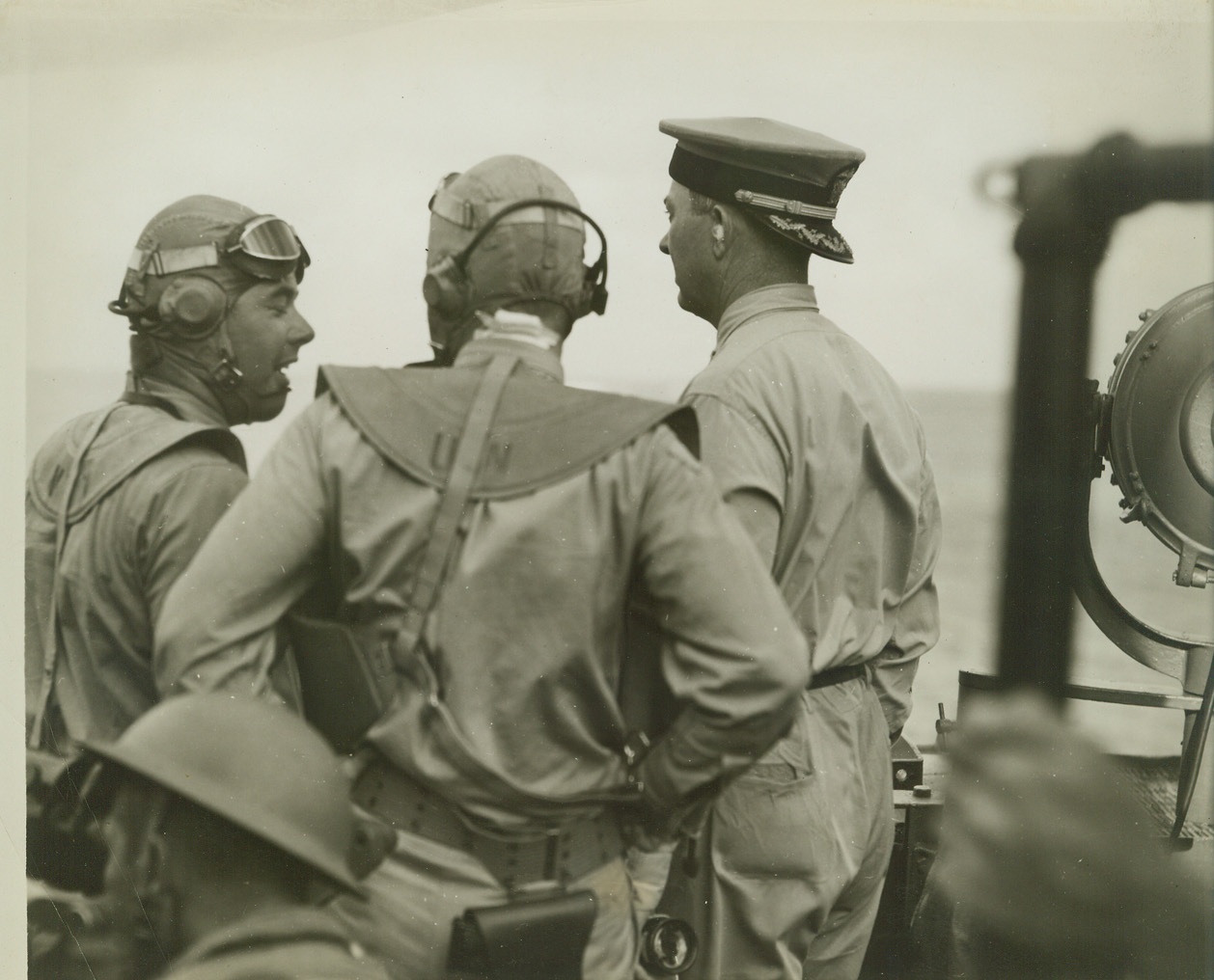
NAVY OFFICERS ON BRIDGE DURING CLASH WITH JAPS, 3/30/1942. SOMEWHERE IN THE PACIFIC – Officers on the bridge of a warship, part of a task force of the United States Pacific Fleet, during a hot engagement with Japs “somewhere in the Pacific.” Officer on right with his hat on backwards is captain of ship. Note cotton stuffed in his ears to protect them from injury during heavy gunfire. Two men on left are Navy fliers. Credit: ACME;

U.S. NAVAL MOBILE BASE HOSPITAL #1, BERMUDA, 3/6/1942. The U.S. Navy has a mobile hospital in Bermuda, which is plainly marked and is far removed from any military objectives. The hospital is made up from prefabricated buildings and some of the quarters are tents. Special equipment has to be used in case it is decided that the buildings should be moved. Men attached to the Navy Medical Corps are capable of setting up such a hospital but it has been learned that it’s not good economy to have the labor of construction performed by Medical Corps men unless it is a case of absolute necessity. A unique feature of the sterilizing room. The necessary heat being furnished by oil burners of a special design. Credit: U.S. Navy photo via OWI Radiophoto from ACME;

U.S. NAVAL MOBILE BASE HOSPITAL #1, BERMUDA, 3/6/1942. The U.S. Navy has a mobile hospital in Bermuda, which is plainly marked and is far removed from any military objectives. The hospital is made up from prefabricated buildings and some of the quarters are tents. Special equipment has to be used in case it is decided that the buildings should be moved. Men attached to the Navy Medical Corps are capable of setting up such a hospital but it has been learned that it’s not good economy to have the labor of construction performed by Medical Corps men unless it is a case of absolute necessity. A general view of the unit used in connection with Uncle Sam’s bases. Various field laboratories and buildings for operating rooms are all plainly marked with a red cross. Credit: U.S. Navy photo via OWI Radiophoto from ACME;
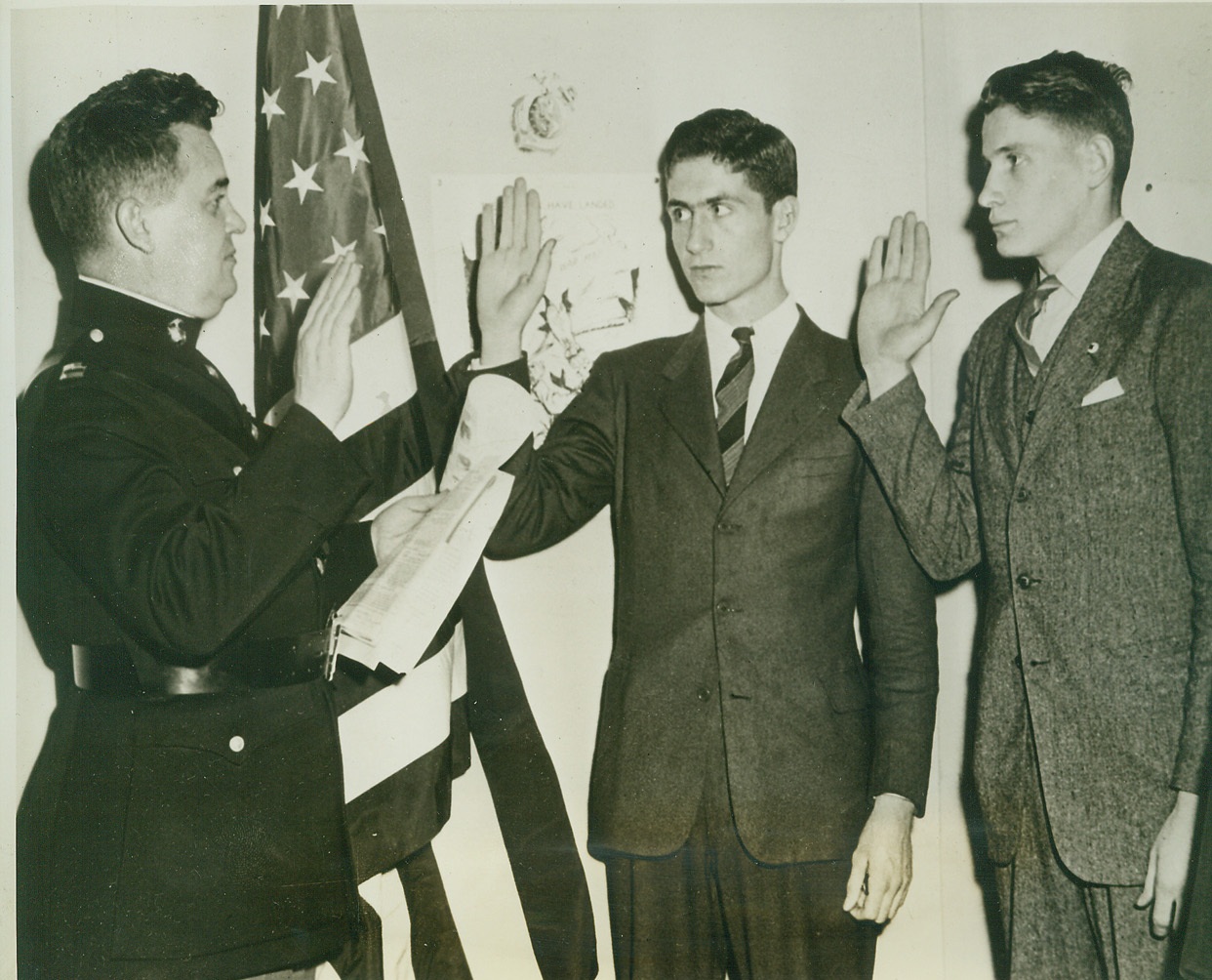
Hatfields and McCoys Patch Up Against Axis, 3/6/1942. CHARLESTON, W. VA. – That bloody mountain feud between the Hatfields and McCoys officially is over for the duration. Pictured proof here shows Edward LaPort, right, whose mother was a McCoy, and Cabell Terry Hatfield, center, taking the oath from Capt. Robert W. Gordon, Marine Corps recruiter at Charleston, W.Va., that they will blast the Axis and not each other. Credit: (ACME);

SPECIAL TRAIN CARRYING TROOPS IN HEAD-ON CRASH, 3/7/1942. GRANBY, MO. – Seven persons were killed and at least forty-five were injured when a special train carrying troops and a fast Frisco passenger train, the Will Rogers, collided head-on in the middle of a trestle at Granby. Four of the dead were soldiers who were among 230 recruits enroute from Camp Grant, Ill. The other three were crew members on the Will Rogers. Railroad officials said a mix-up in signals was responsible for the head-on collision. Passed by Army censor. Credit: ACME;
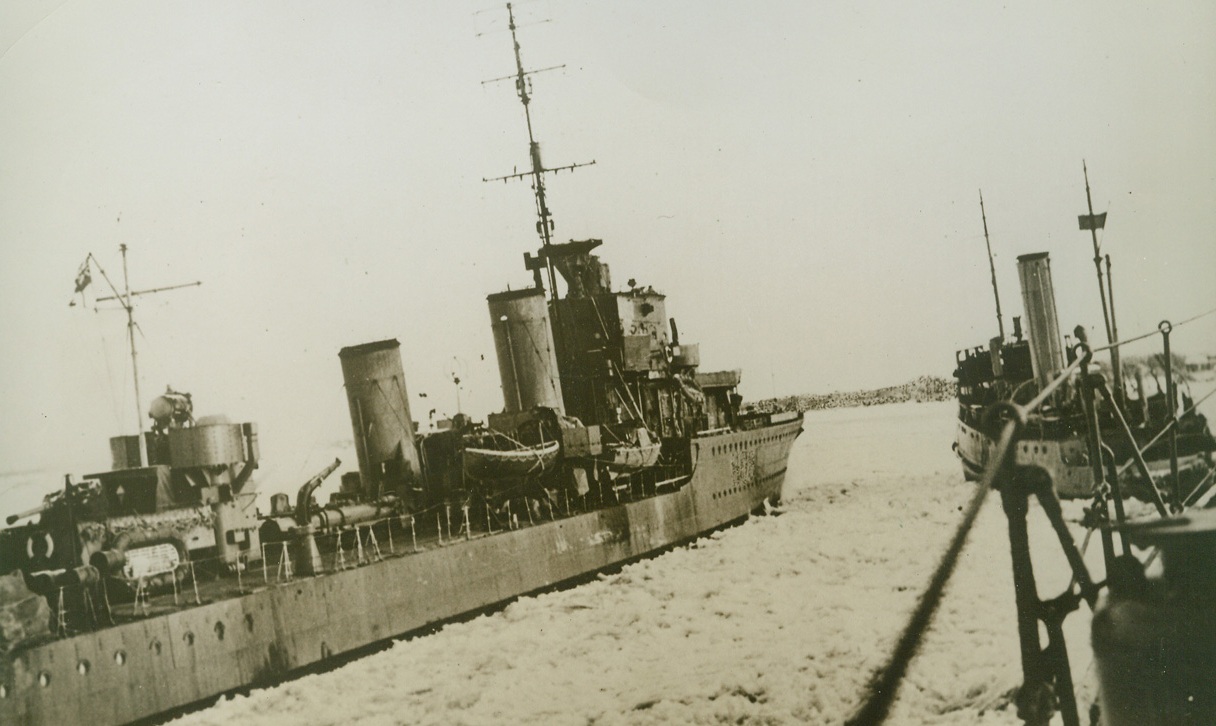
FRIGID GOING, 3/7/1942. Braving the extreme conditions of Arctic winter, a British convoy steams safely through ice-covered waters with supplies for the Soviet Union. A Russian tug is ready to pilot the ships safely into harbor. Credit: Acme;
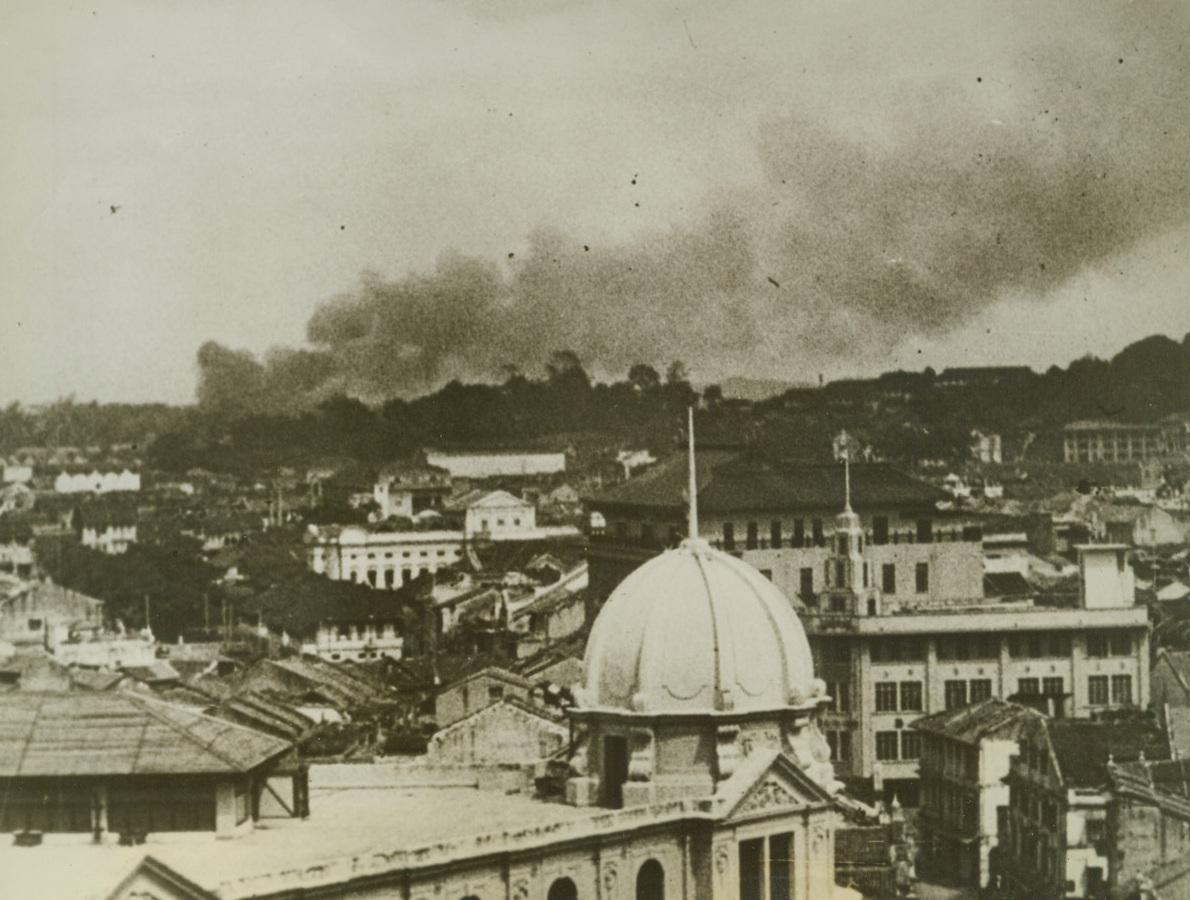
SMOKE HOVERS OVER DOOMED SINGAPORE, 3/8/1942. SINGAPORE, MALAYA—Blasted by bombs and artillery fire, doomed Singapore huddles beneath a dense pall of smoke shortly before its capture by the Japanese. Credit: Acme;
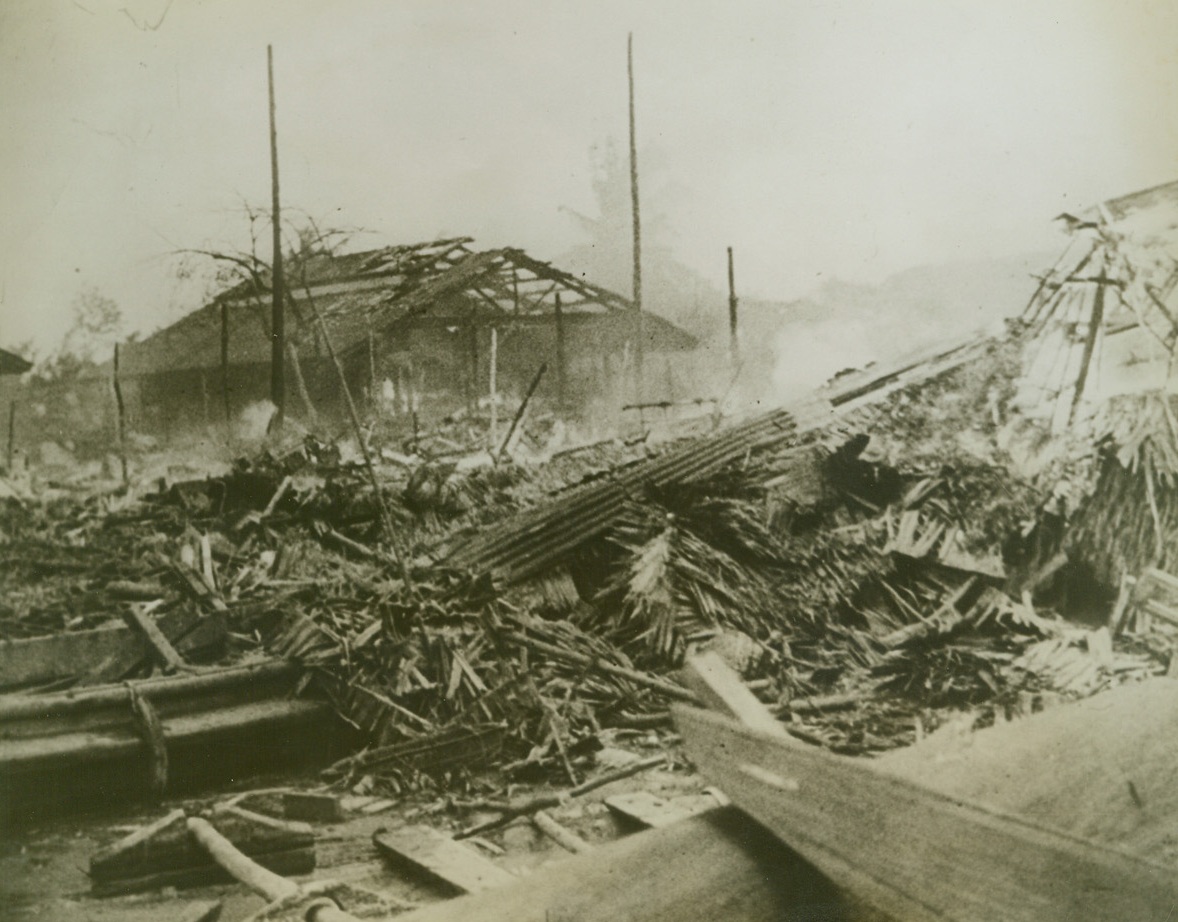
JAPANESE TOUCH ON SINGAPORE, 3/8/1942. SINGAPORE, MALAYA—Frail native huts are masses of smoking and splintered ruins after a visit by Japanese bombers during the last few days of British possession of the Malayan capitol. Credit: Acme;
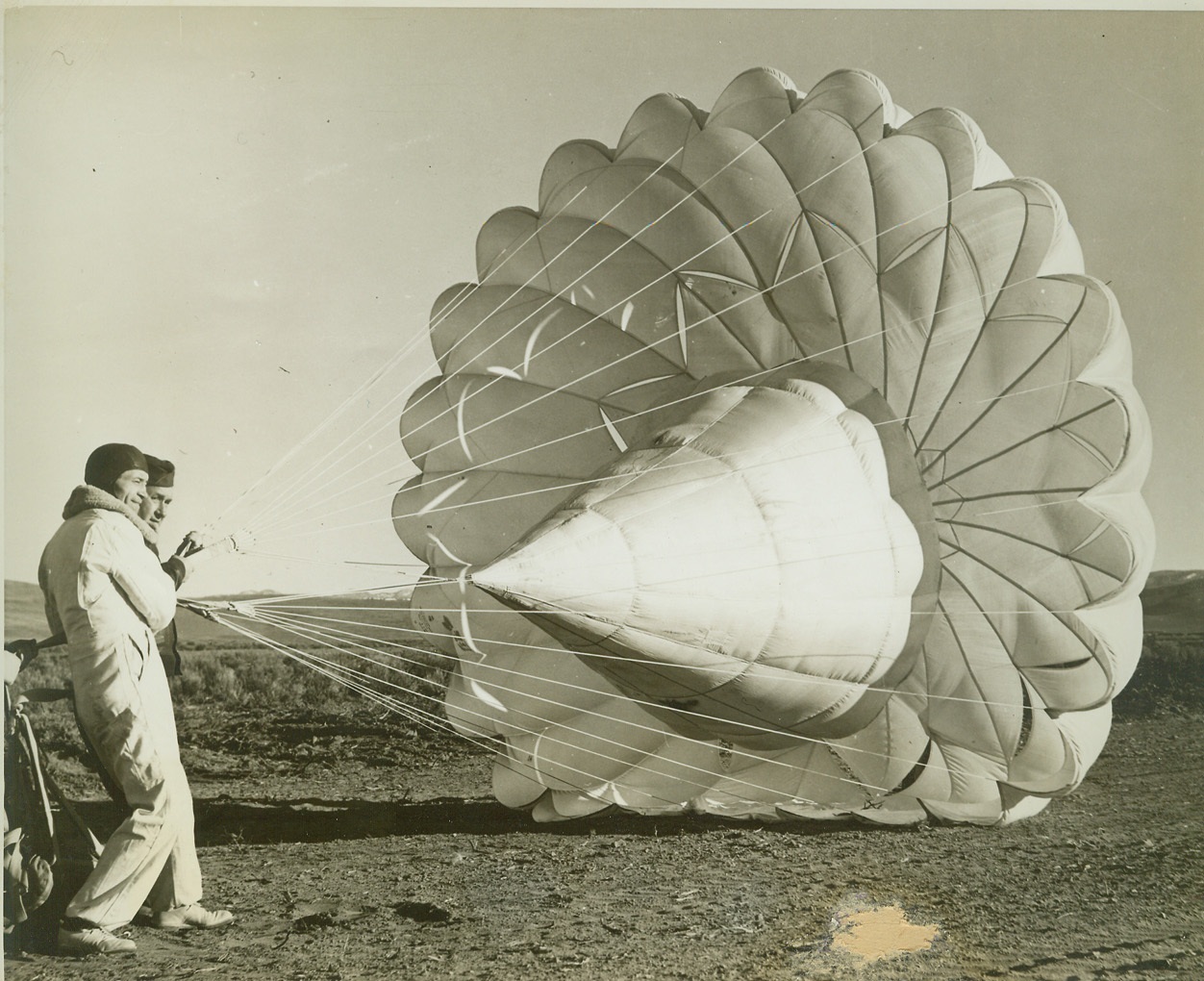
Army Tests New Type Parachute, 3/8/1942. Reno, Nev.—Utilizing a center cone (illegible portion here), opening shock and reduce speed of (illegible portion), a new type parachute is shown after its first Army tests by Jumper George Waltz. In foreground is the inventor, Dr. Christian Wolf. Waltz made the first test jump from 2700 feet. Credit: ACME;
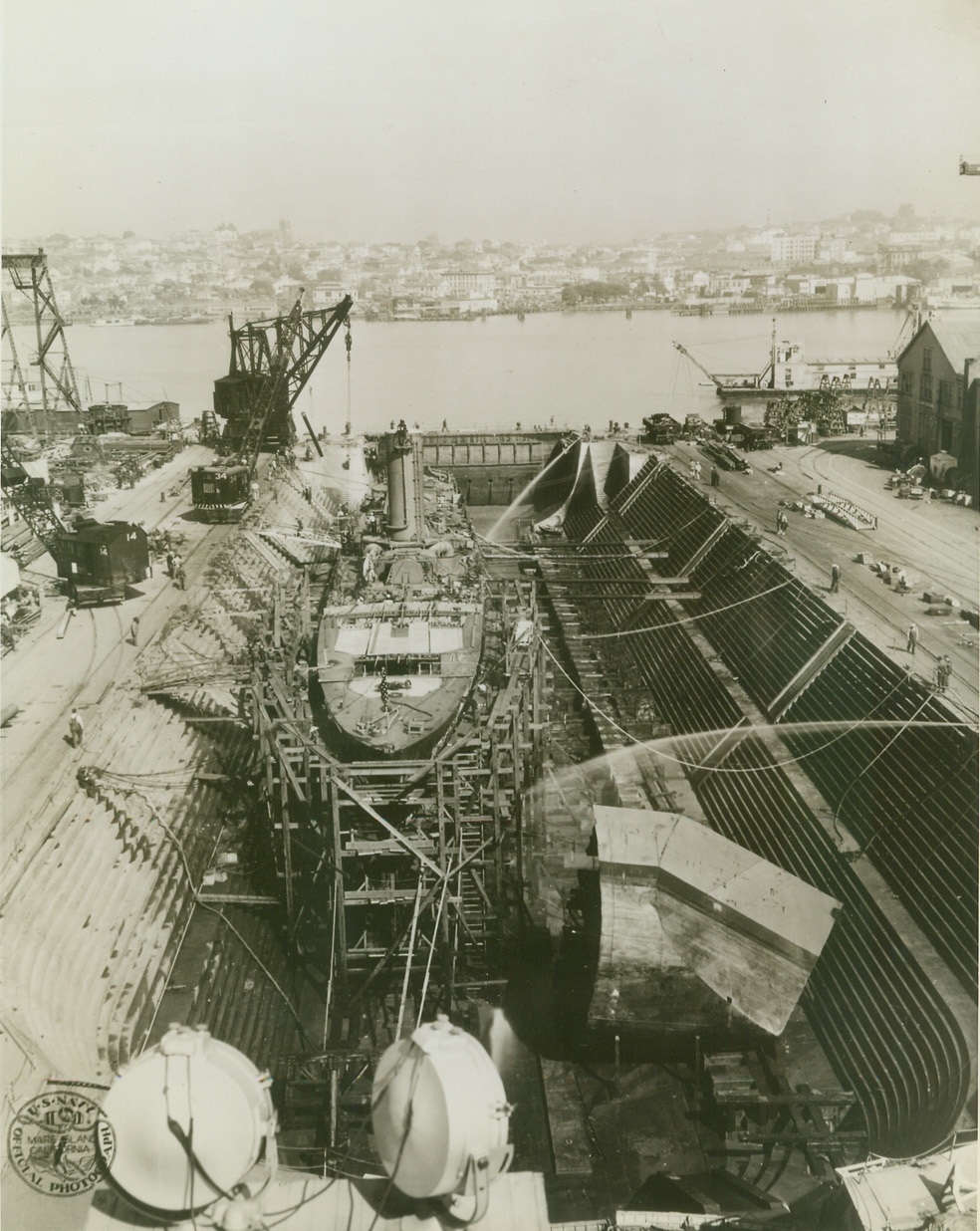
USS SHAW TAKE A BOW, 3/9/1942. AT A PACIFIC COAST NAVY YARD – The Destroyer USS Shaw is whole once again. The long, lean “sea greyhound” is shown in drydock with a new forward section to replace the temporary snub bow (right foreground) which was fitted to the vessel after damage suffered in the Japanese attack on Pearl Harbor on Dec. 7. The Destroyer arrived here under her own power. Credit: U.S. Navy photo via OWI Radiophoto from ACME;
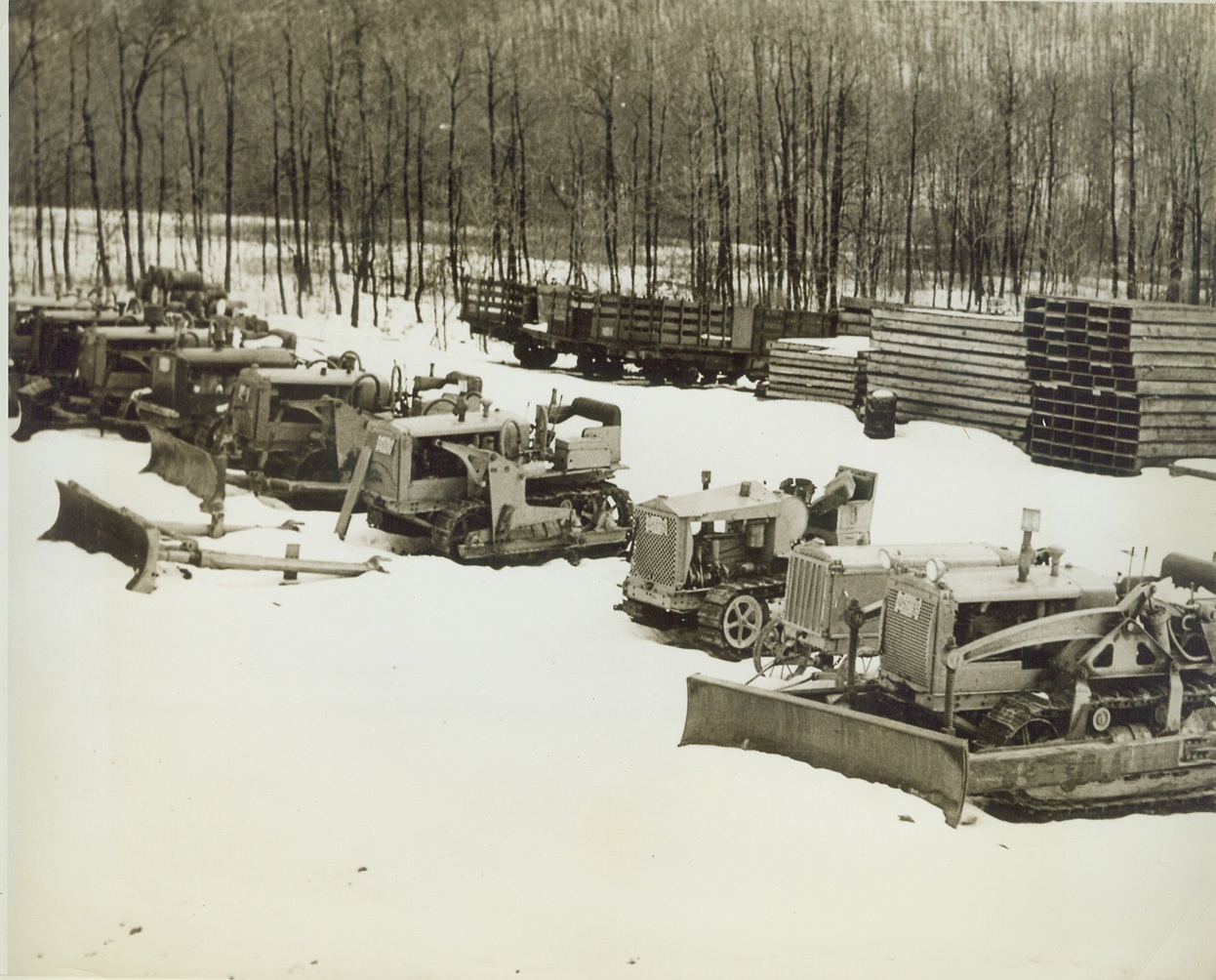
DEFENSE MATERIAL BEING WASTED BY CCC, 3/9/1942. Valuable and vital defense material is being wasted and wrecked by the Federal Civilian Conservation Corps in the abandonment of some of its camps in Pennsylvania, according to a copyrighted story in the Philadelphia “Inquirer,” March 8. While the war production board is attempting to utilize all “surplus war materials,” CCC storehouses are loaded to the ceiling with brand-new tools, the story states, and in spite of the dwindling civilian supply of all-wool clothes, brand-new, unpacked supplies of long underwear, uniforms, oilskin raincoats, rubber overshoes and even army blankets have been burned by the CCC. While Price Administrator Leon Henderson has announced it might be necessary to requisition tires from private owners for use of the armed forces, there is one CCC storehouse packed with at least 1200 good truck tires, some of them virtually new. While autos and trucks are being rationed, the CCC is permitting usable trucks to rust and rot in open fields, unprotected from severe winter weather. While there is a shortage of road equipment, graders and caterpillar tractors are wasting away in the same manner. This story was written about only certain camps in Pennsylvania – and there have been camps in 47 other states, many of which have been closed down. NEW YORK BUREAU These tractors left to rust in the snow of an open field might be doing their bit for national defense. Credit: ACME;
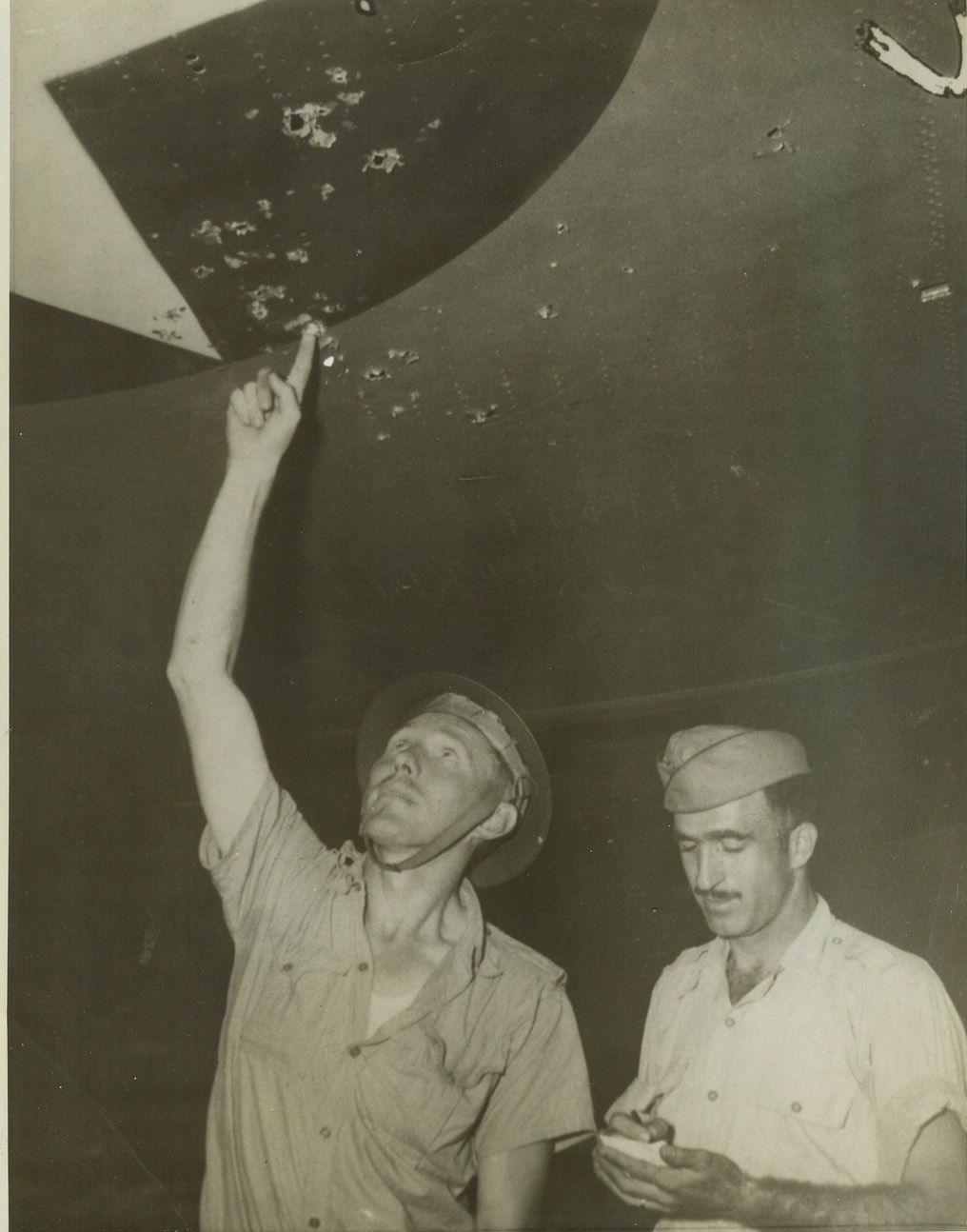
U.S. FLIERS WHO AID “AUSSIES” INSPECT DAMAGE TO THEIR SHIP, 3/9/1942. In one of the first pictures from Australia since the United States entered World War II, two U.S. Army “Flying Fortress” crew members examine the wing of their ship which was struck “a few times” by Jap bullets during a tiff with the invaders in the South Pacific. Now in Australia to bolster the Allied Forces, this was one of the “Flying Fortresses” to see action against the Japanese in the Philippine area. Credit: ACME;

CCC Equipment, 3/9/1942.
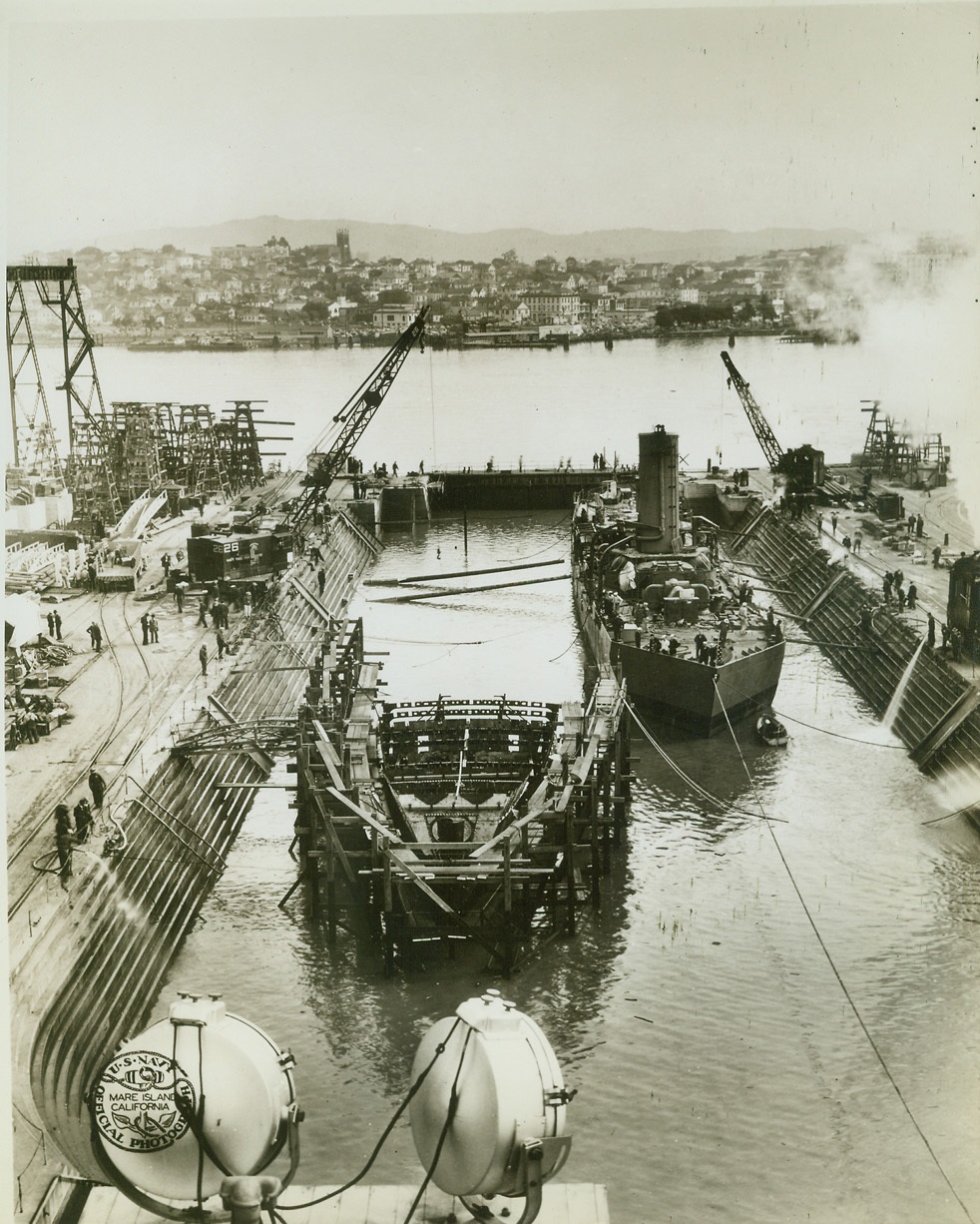
USS SHAW TAKES A BOW, 3/9/1942. AT A PACIFIC COAST NAVY YARD – The destroyer USS Shaw, badly damaged in the Dec. 7 attack on Pearl Harbor, is shown being floated into drydock for the removal of her temporary bow and the addition of her new forward section, shown in left foreground. The temporary snub bow was fitted onto the Shaw after the vessel was blasted at Pearl Harbor. She reached the mainland under her own power. Credit: U.S. Navy photo via OWI Radiophoto from ACME;

TOMB FOR FIFTY IN SOERABAJA, 3/14/1942. SOERABAJA, JAVA – Rescue workers work to save people trapped when a railroad car under which they had taken refuge during the Japanese bombing of the city was struck by an aerial explosive. Fifty men and women met death under the car. Radioed to New York. Credit: ACME;
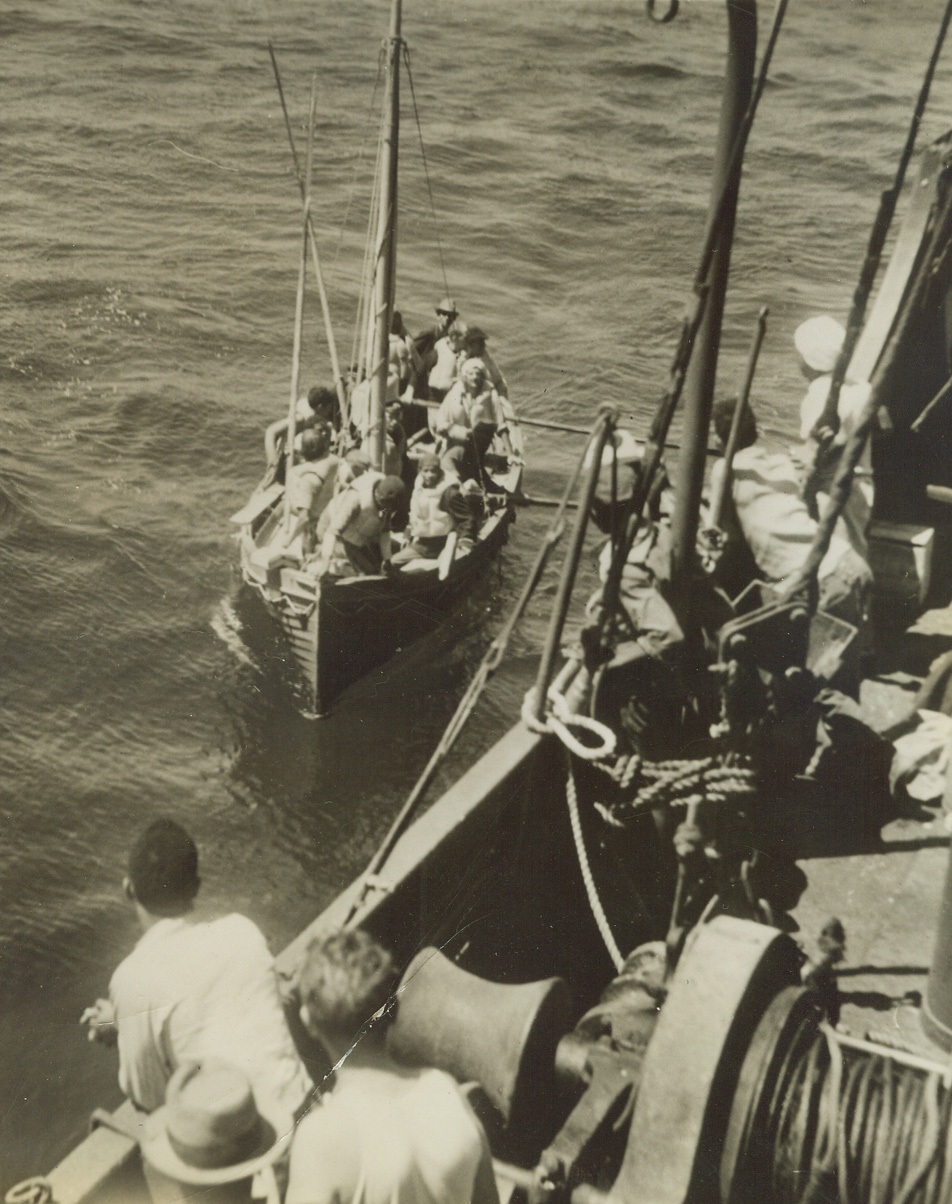
South Atlantic -- Merchant Vessel Crew Being Rescued After Losing Their Ship, 3/23/1942.
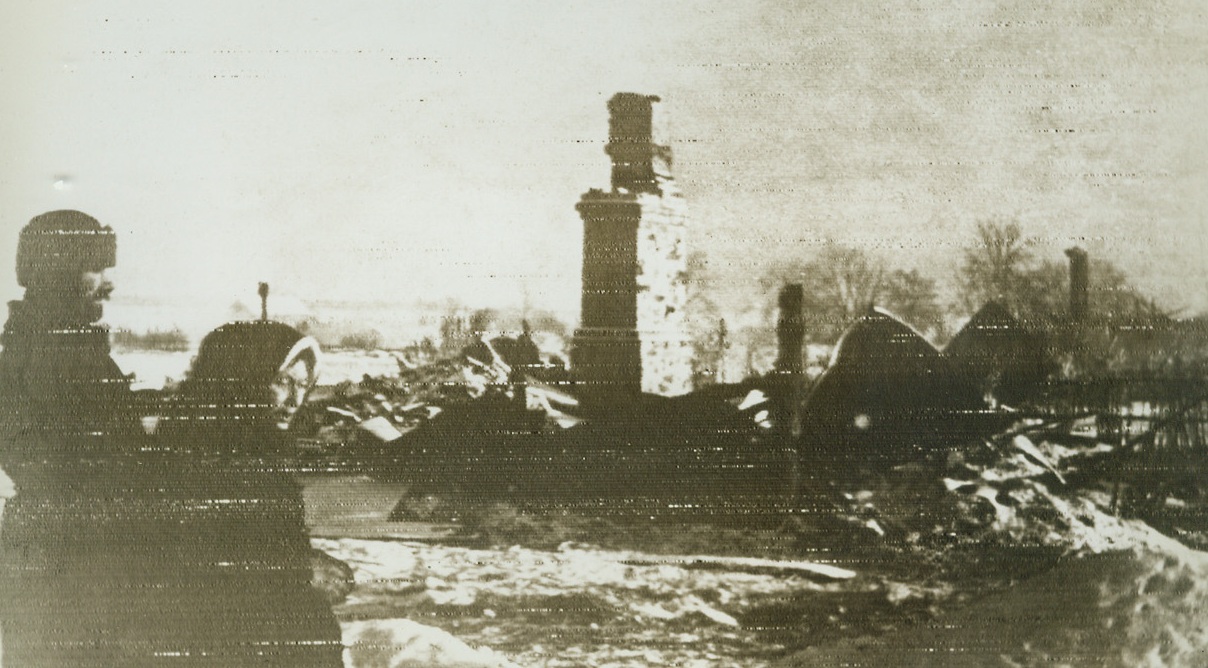
WORK OF RETREATING GERMAN ARMY IN RUSSIA, 3/8/1942. RUSSIA—A soviet peasant couple stand before the ruins of their home, destroyed when retreating Germans fired the village. Radiophoto was flashed to New York from Moscow today. Credit: ACME RADIOPHOTO;
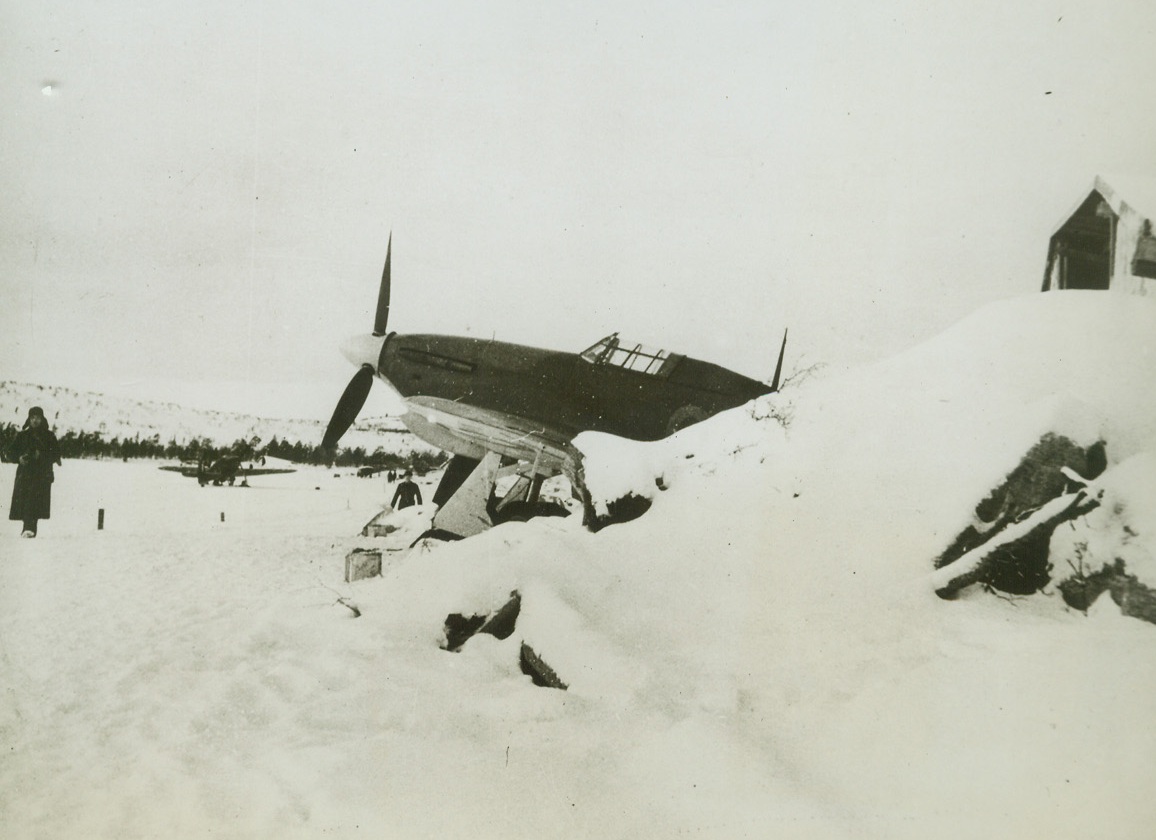
BRITISH “HURRICANES” SNOWED IN RUSSIA, 3/12/1942. ON THE NORTH RUSSIAN FRONT—British “Hurricane” fighters snowed in their dispersal bays, “Somewhere in North Russia.” These planes, with their replacement equipment, were turned over to the Russians by British flyers to help prevent a German push through Norway into Northern Russia. Credit: ACME.;
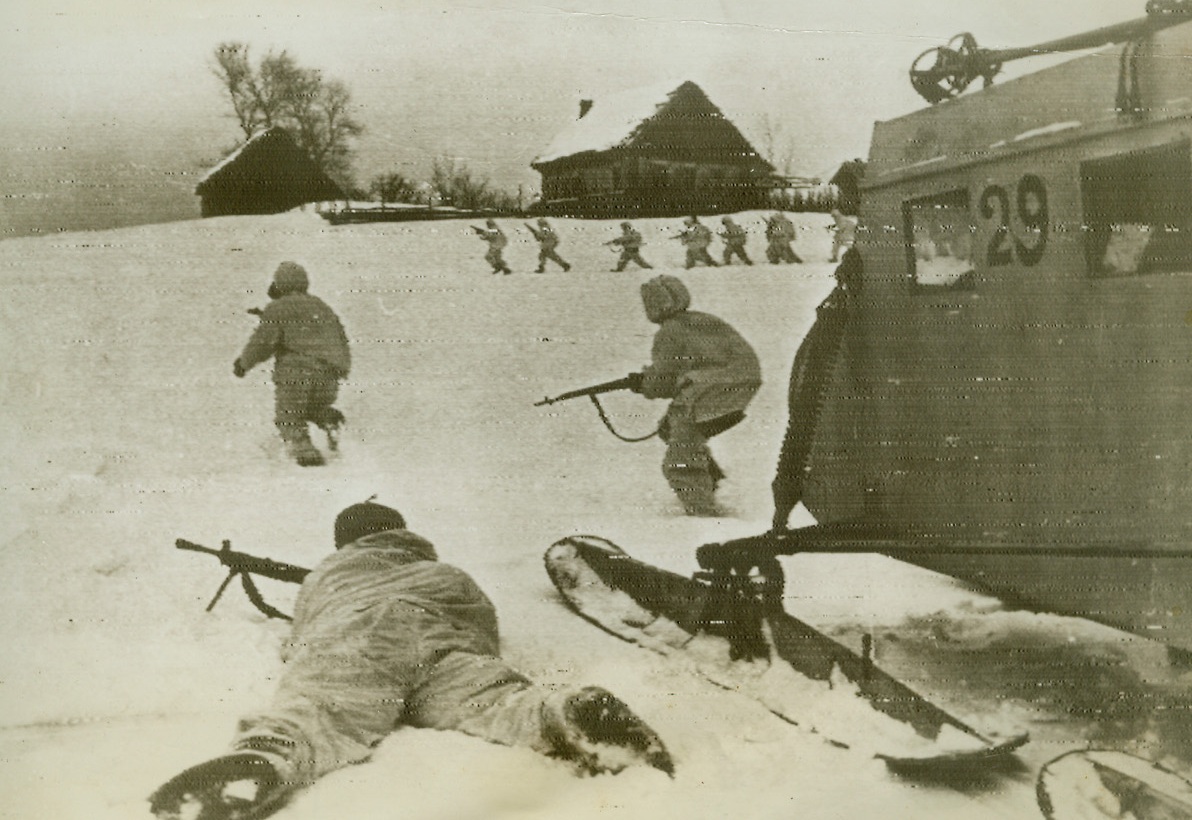
Air Sledges Aid Red Advance, 3/23/1942. RUSSIA—Operating out of a propeller-powered sledge, Russian soldiers advance at a point in the rear of German lines, according to the Russian-censored caption on this photo from Moscow.Credit: ACME Radiophoto;

Russians Pursue Retreating Germans, 3/8/1942. ROSTOV-ON-DON, RUSSIA—One of the most graphic action pictures to come out of the war, this Russian Ministry of Information photo shows Soviet soldiers hunting down German stragglers in retaking the city of Rostov-On-Don in November, 1941. One Russian, at right, has apparently fallen, never to rise again, and another at left may be hit. Passed by censor.Credit: ACME;

The Capture of Yukhnov, 3/25/1942. Yukhnov, Russia – Column of Russian troops as recaptured the town of Yukhnov, left in ruins by the Germans. The town was occupied by Red troops on March 5, according to Soviet dispatches. (Passed by Censors). Credit: ACME;
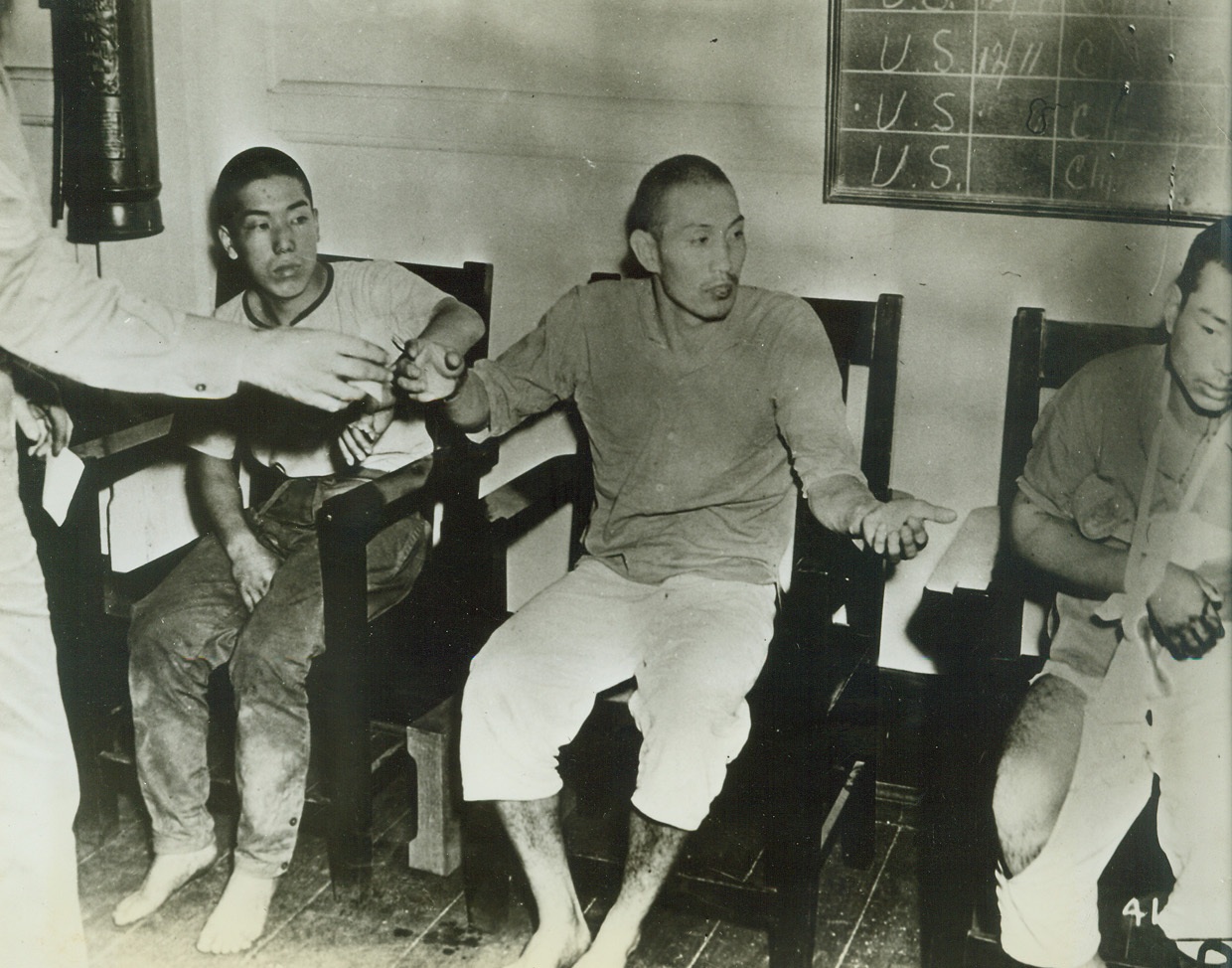
Jap airmen captured after Filipino attack., 3/30/1942. This picture released on March 30th is one of the first brought out of the Philippines since the start of hospilities. It was rushed from Australia to the capital for release by the pictorial branch of the War dept., Bureau of Public Relations. Photo shows – Three Japanese aviators who were shot down and taken prisoner during the raid on Manila. Credit line (U.S. Army photo from ACME);

U.S. Cruiser Bombarding Wake Island, 3/25/1942. A United States Pacific fleet task force carried out a surprise attack on Japanese occupied Wake Island on Feb. 24th, smashing shore installations sinking two patrol boats and demolishing 3 large seaplanes. The U.S. Navy announced in Washington on March 25th. The above photo released simultaneously by the Navy shows a U.S. cruiser as her main battery bombarded the Jap forces on Wake island as anti-aircraft crews stand by. Credit line (U.S. Navy official photo from ACME);
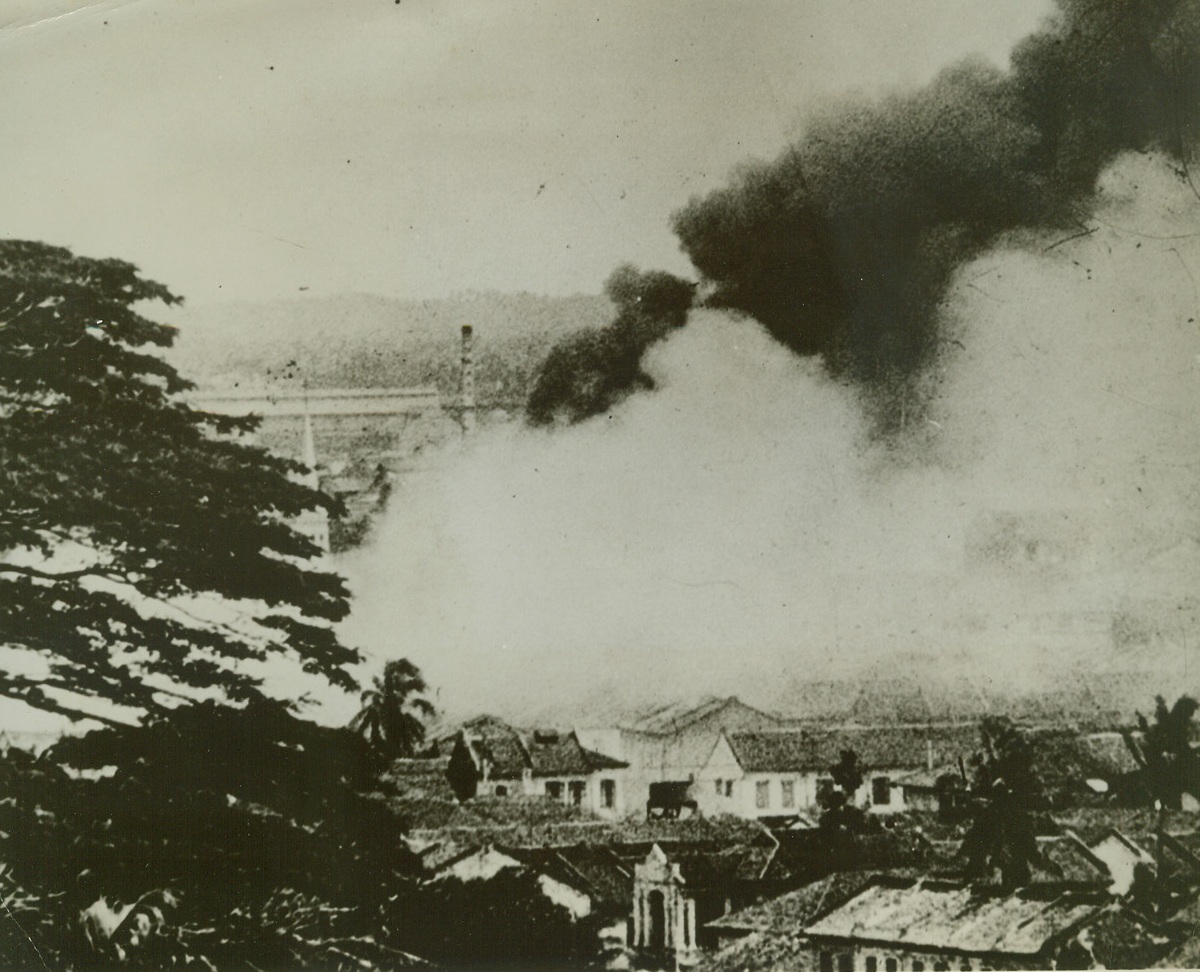
Singapore Blazes as Japs Move In, 3/17/1942. Singapore, Malaya – One of the last pictures to be made of beleaguered Singapore, this shot shows a huge column of smoke rising from countless fires created by Japanese incendiary bombs. Credit line (ACME);
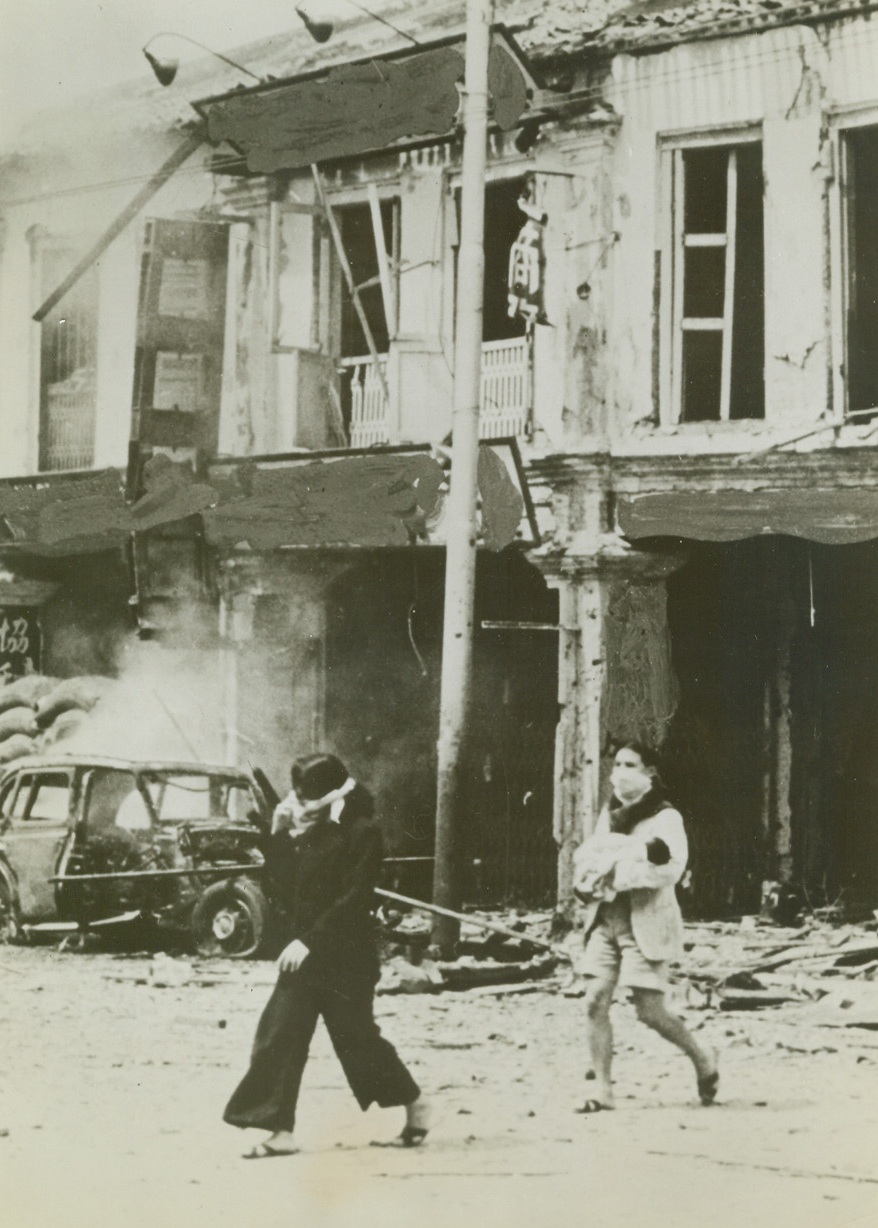
Last Days of Singapore, 3/17/1942. Singapore – Handkerchiefs tied across their faces to serve as improvised masks against the sting of explosion gases, natives of Singapore, one of whom carries a baby in her arms, are rushing from a bombed and burning building. The last days of the Great British bastion were a nightmare of incessant bombings, fires and the tortures that came through a lack of water after the Japanese cut off the water supply to the city. Credit line (ACME);

Reinforcement for an Already Strong Shelter, 3/13/1942. Sydney, Australia – On Sydney’s home front, preparations proceed apace for expected aerial invasion tries, with sandbags reinforcing already strong shelters. ‘Professionals’ have erected this sandbag for around a shelter which will accommodate 50 people in its two rooms. The cost was 100 pounds, a little less than $500. This is just one of the many fortified homes and offices in Sydney. Credit line (ACME);
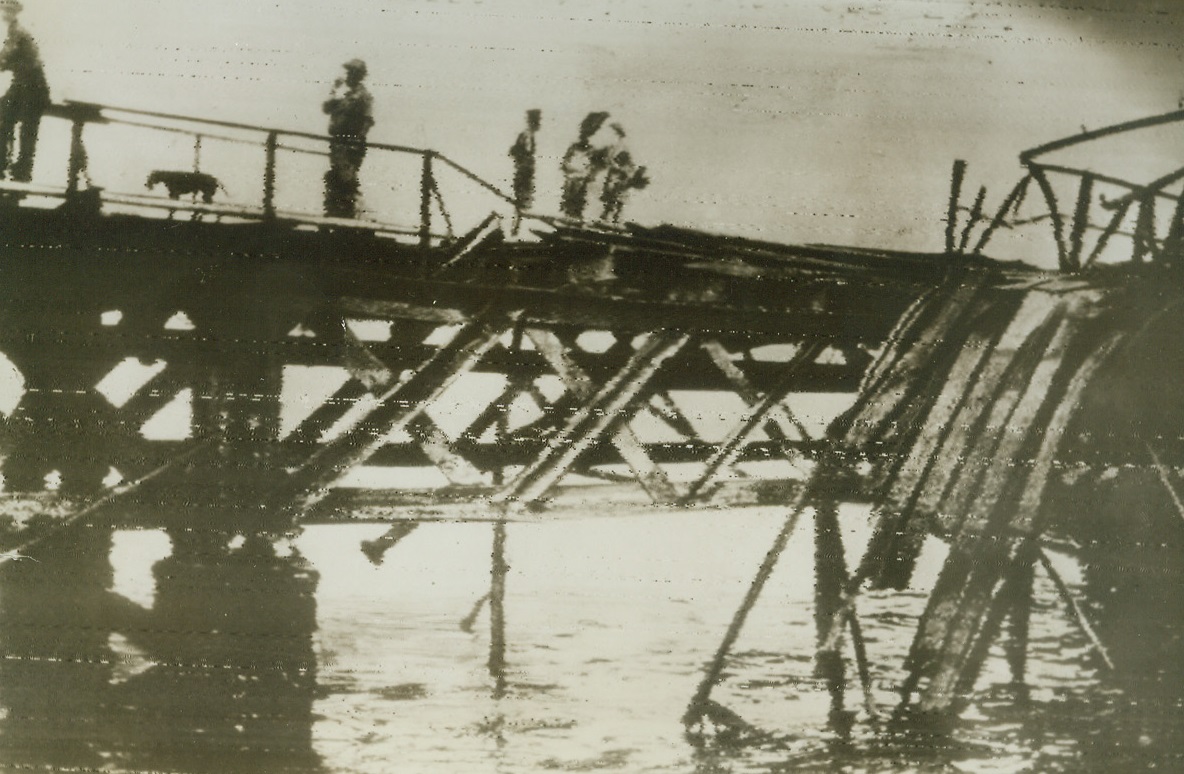
Bridge Blasted in Jap Raid on Darwin, 3/7/1942. Port Darwin, Australia – This bridge was blasted by Jap planes which raided Port Darwin, on Australia’s Northern coast. Photo was radioed to London and relayed by radio to New York today. Credit ACME Radio photo;
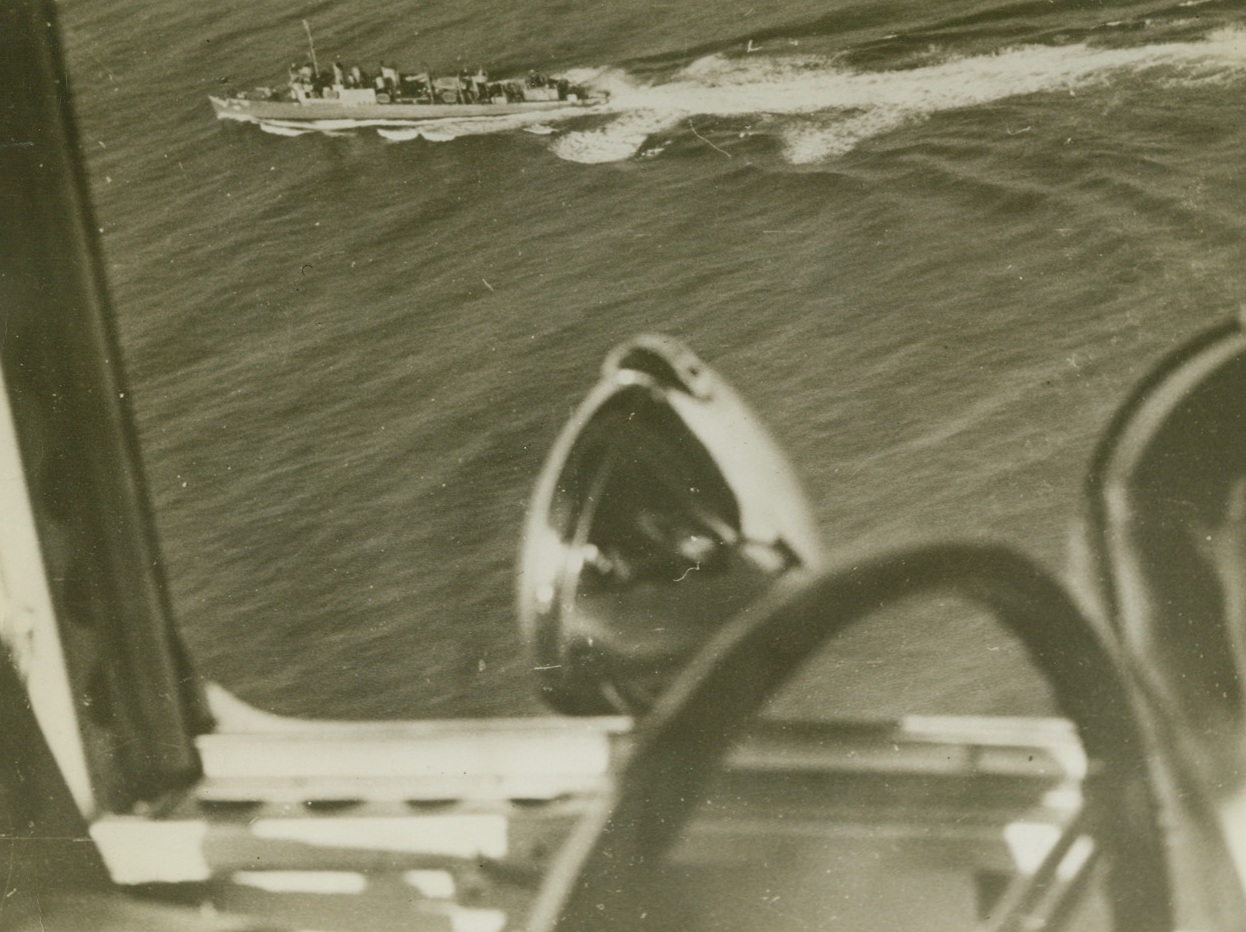
Destroyer at Work, 3/14/1942. A Navy blimp on coastal patrol is an interesting bystander as a destroyer flings four depth charges into the sea in a vicinity where two United Nations ships were torpedoed. Photo was made from the blimp during the routine patrol flight. Destroyer let go with the charges after picking up a U-Boat with her listening apparatus. Credit: ACME.;

Drifted for 11 Days Before Rescued, 3/23/1942. After eleven days spent in two open boats, 27 survivors (the entire crew) of a small Allied merchantman ship sunk in the South Atlantic March 5, were picked up and all appeared in good shape. A survivor is shown drinking warm water from a tea kettle aboard the rescue ship as another climbs rope ladder. The rescued men said today that their vessel was shelled and machine-gunned for nearly a half-hour by an Axis sub in an obvious attempt to conserve its precious torpedoes. Credit: ACME.;
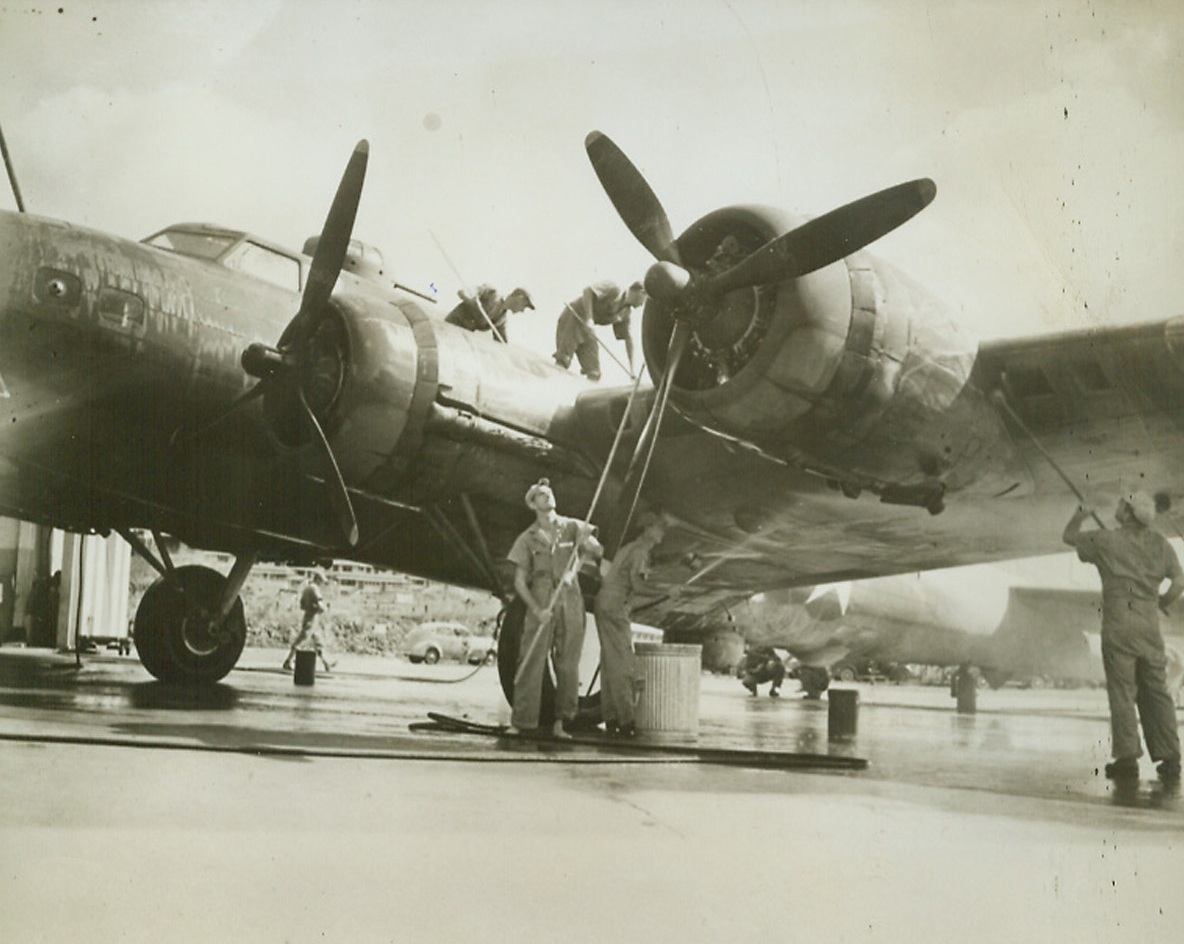
Giving Baby a Bath, 3/21/1942. Panama Canal Zone—Just in from a patrol over the vital Panama Canal, a big Army four-motored bomber gets a scrubbing before being put to bed by its watchful mechanics.Credit: ACME.;

Ready for Takeoff, 3/7/1942. Hawaii—The crew of a Flying Fortress of the Hawaiian Air Force Bomber Command board their plane as they prepare to take off on a patrol flight.Credit: ACME.;
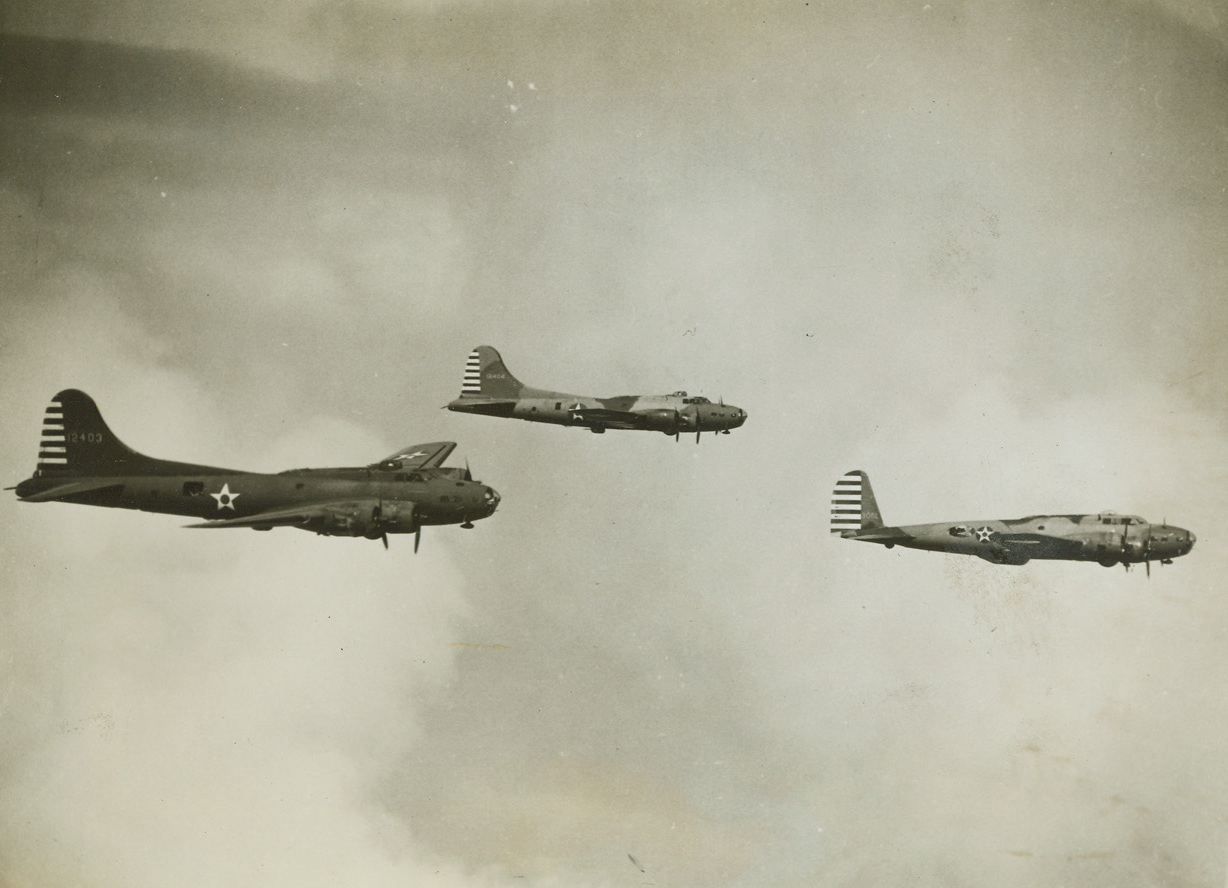
Defenders of Hawaii, 3/7/1942. Hawaii—A trio of powerful Flying Fortresses of the Hawaiian Air Force Bomber Command fly in formation over Uncle Sam’s vital Pacific defense outpost.Credit: ACME.;
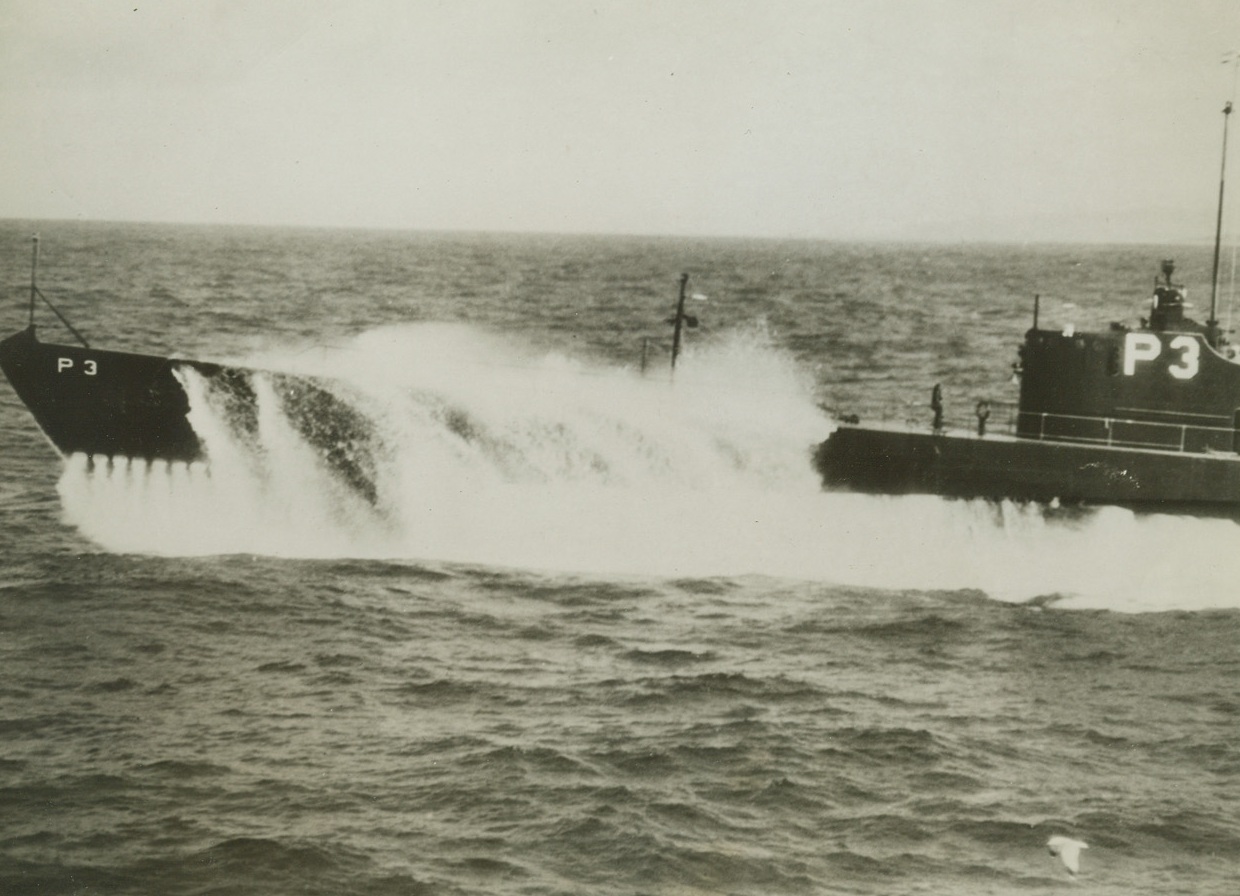
American Sub Presumed Lost, 3/18/1942. Washington, D.C.—The Navy today disclosed that the U.S. Submarine Shark was overdue in the Far East for more than a month and must be presumed to be lost. The next of kin of the personnel of the Shark have been notified.Credit: ACME.;
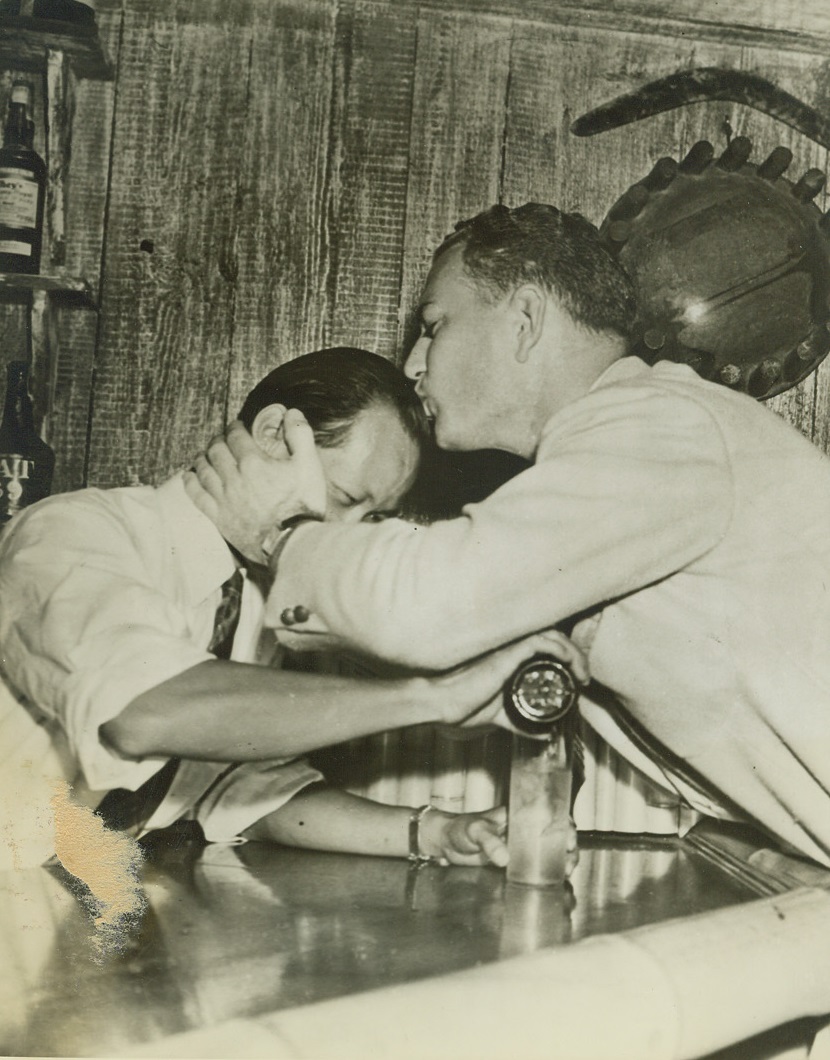
Welcome Home for an Old Friend, 3/8/1942. Honolulu – Overjoyed at the return of the privilege of standing up to a bar and ordering a long, cool one, citizen Walter Clarke plants an appreciative kiss on the head of his favorite bartender as officials allowed the return of liquor for a 30-day probationary period. It hadn’t been allowed since December 7. Credit: ACME;

Depth Charge, 3/14/1942. Teaming up with a Navy blimp to ferret out U-boats in a vicinity where two United Nations ships were torpedoed, a Coast Guard cutter drops a depth charge on a spot where a sub is believed to have crash-dived. PHC-to was made from the blimp during the routine patrol flight. Credit: ACME;
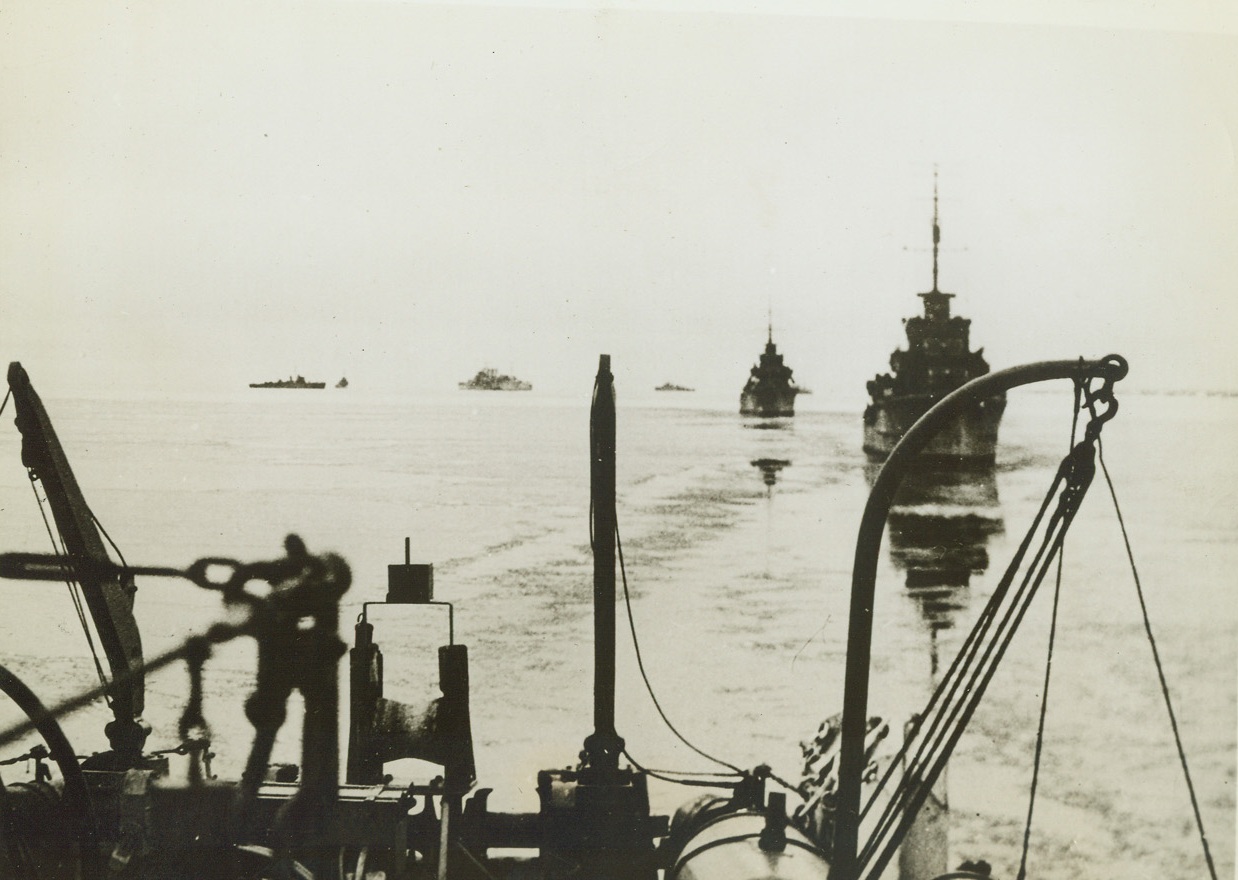
BRITAIN DELIVERS THE GOODS, 3/7/1942. The winter sun of the Arctic breaks through as a British convoy steams cautiously through the ice-crusted waters of the Northern Soviet coast. Not even the bitter weather of Arctic winter has kept the British ships from getting through to the Soviet Union with their precious cargoes. Credit: Acme;
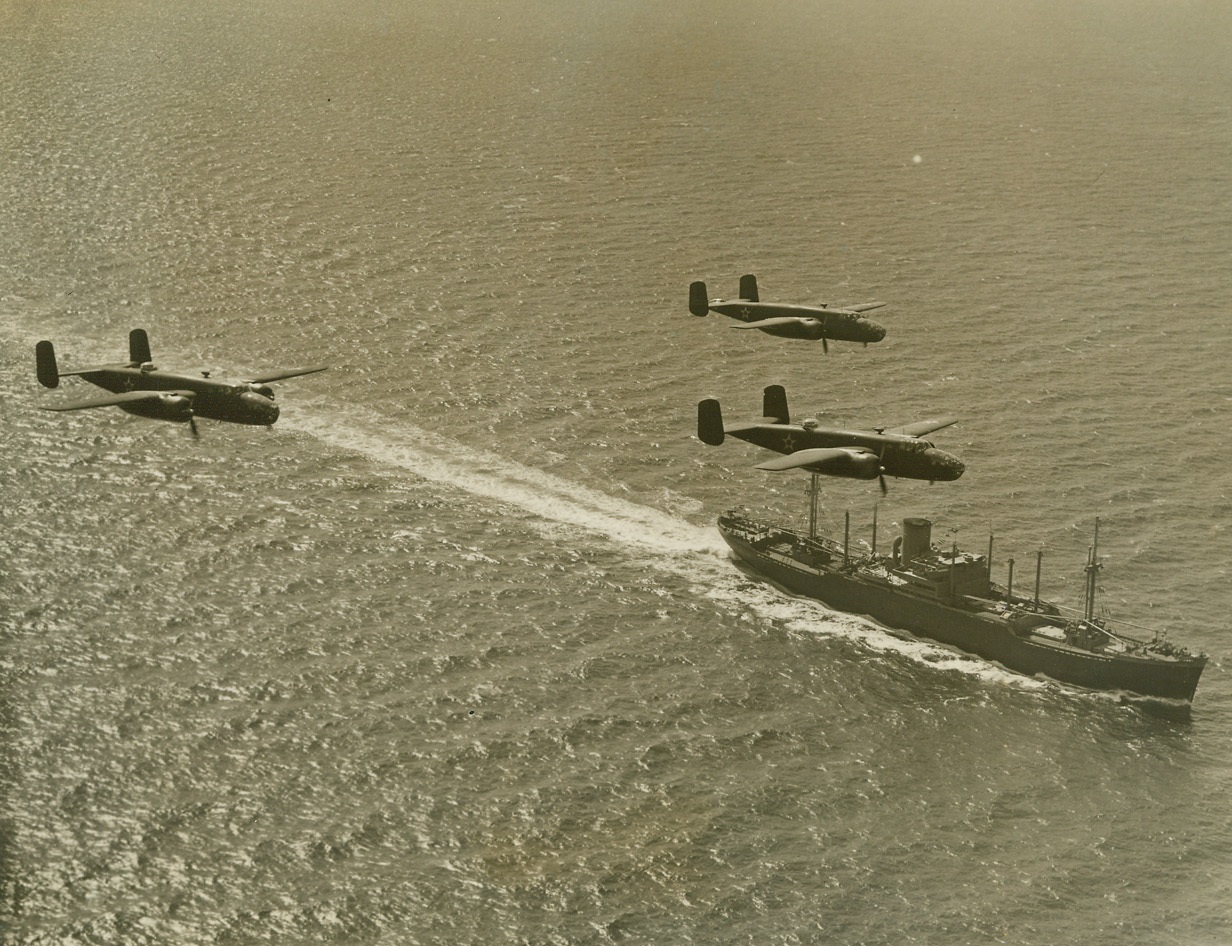
American Bombers on Atlantic Patrol, 3/24/1942. The Atlantic Ocean – Over a seagoing vessel three Army B-25 bombers roar during their ceaseless patrol of the Atlantic coast, ever alert for enemy planes, surface ships or submarines. It is these planes and their fellows in the Army and Navy Air Forces which have been charged with the defense of the U.S. Atlantic Coast and which have sunk an unannounced number of submarines operating in that area. They are part of the command of Maj. Gen. Follett Bradley, head of the Air Forces, Eastern Defense Command and First Air Force. Passed by U.S. Censor. Credit: ACME;





 Trash & Recycling
Trash & Recycling
 Online Payments
Online Payments
 City Documents
City Documents
 Parks
Parks
 Traffic Court
Traffic Court
 CITY PARKS
CITY PARKS
 Outdoor Recreation
Outdoor Recreation
 Volunteer
Volunteer
 Home
Home TRANSLATE
TRANSLATE
